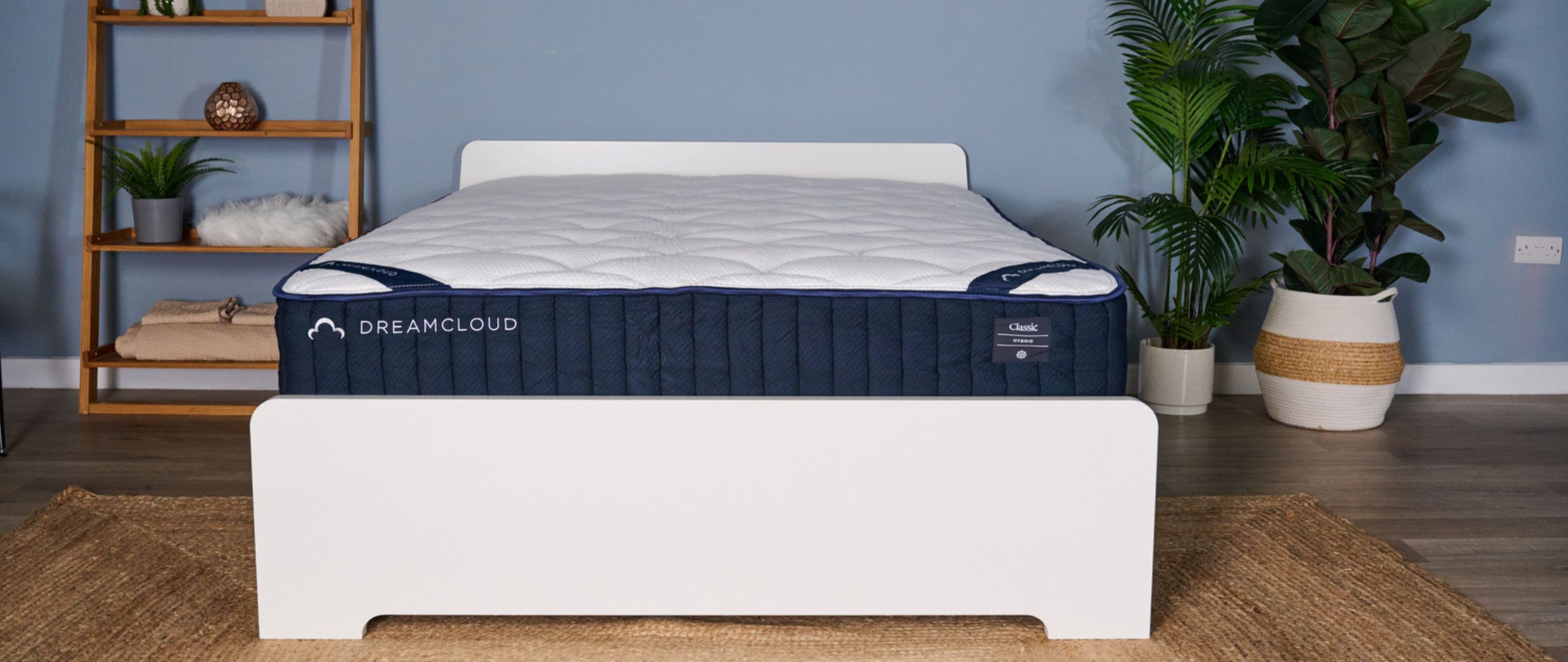Tom's Guide Verdict
The DreamCloud is the most impressive, budget-friendly mattress we’ve tested (with the even cheaper Siena Signature being a very close rival). With an outstanding performance across all areas of support and comfort, the DreamCloud rivals even the Saatva Classic, our top-rated bed overall, which is impressive considering it's $1,000 cheaper. The DreamCloud's soft, cushioning feel stops pressure from building up — ideal for side sleepers, but stomach sleepers will likely need a firmer bed. Couples are unlikely to feel overheat (it performed well in our temperature regulation tests), but they might feel each other’s movements as the motion isolation doesn’t compete with memory foam options. At $699 for a queen, the DreamCloud Classic is unbeatable value. Expect excellent support and cloud-like comfort comparable to the most luxury beds that sell for triple the price.
Pros
- +
Excellent value for money
- +
Easy to move around on
- +
Cushions and contours the body
- +
Supports most sleeping positions
- +
Stable edges
- +
Prevents heat build-up
Cons
- -
Too soft for stomach sleepers
- -
Likely to feel partner's movements
Why you can trust Tom's Guide
DreamCloud Classic review results
Overall score: 4.1 out of 5
| Product | Edge support (Score) | Motion isolation (Score) | Pressure relief (Score) | Value for money (Score) | Temperature control (Score) |
|---|---|---|---|---|---|
| DreamCloud Classic | 4 | 3.5 | 4 | 5 | 4 |

We conduct seven robust tests in our lab to capture objective data on the four areas of a mattress that most affect your sleep comfort: pressure relief, temperature regulation, motion isolation and edge support. We also sleep on a mattress for at least three weeks before subjectively rating it. All of this data is fed into our bespoke scoring system, along with feedback captured by our expert testing panel, to create an overall review score. Read our full mattress methodology here.
The DreamCloud Classic is the brand’s entry-level mattress. With a simple, hybrid design (combining memory foam and coils) and a medium-feel (neither soft nor firm), the mattress is designed to suit most sleepers — including heavier bodies thanks to its 1,000lbs weight capacity.
After our team of experts tested the DreamCloud Classic mattress, we've awarded it second place in our guide to the best mattresses of the year — quite a feat for a bed that comes in at under $700 for a queen.
This makes it one of the best value mattresses we’ve tested and significantly lower in price compared to its major hybrid competitors like the Saatva. Here’s what you can expect if you decide to invest in the DreamCloud Classic in this month’s mattress sales.
Price
- A year-round sale reduces a queen DreamCloud Hybrid to $699
- Includes a full year's trial and forever warranty
- Undercuts most luxury hybrids by $1,000 for a queen
Cost is one of the DreamCloud's strongest features, as the lower mid-range price tag masks a mattress that feels more expensive — but we'll get into that later. Here, we're exploring the pricing of the DreamCloud based on our mattress sales tracking.
First, you can ignore the "total value." That's the DreamCloud equivalent of an MSRP but a year-round DreamCloud mattress sale typically knocks around 50% off. Here are the 'official' total values for the DreamCloud mattress, and how much you can expect to pay.
- Twin: MSRP $1,148 (usually sold at $399)
- Twin XL: MSRP $1,264 (usually sold at $549)
- Full: MSRP $1,531 (usually sold at $579)
- Queen: MSRP $1,698 (usually sold at $649)
- King: MSRP $2,098 (usually sold at $849)
- Cal king: MSRP $2,098 (usually sold at $849)
- Split king: MSRP $2,562 (usually sold at $1,098)
In the current sale, a queen size DreamCloud Hybrid is $699. We've seen the price fluctuate this year but you can expect to pay between $649 and $699 for a queen. Even at the higher end of that bracket, this is a competitive price.
During major sales periods, like the Black Friday mattress deals now, you can also get $599 of free bedding with your purchase.
Get instant access to breaking news, the hottest reviews, great deals and helpful tips.
And if you're a real bargain hunter, we did spot the older DreamCloud model at a mega discount on Amazon during the July Prime Day sale. if we're lucky, this deal might be back this November.
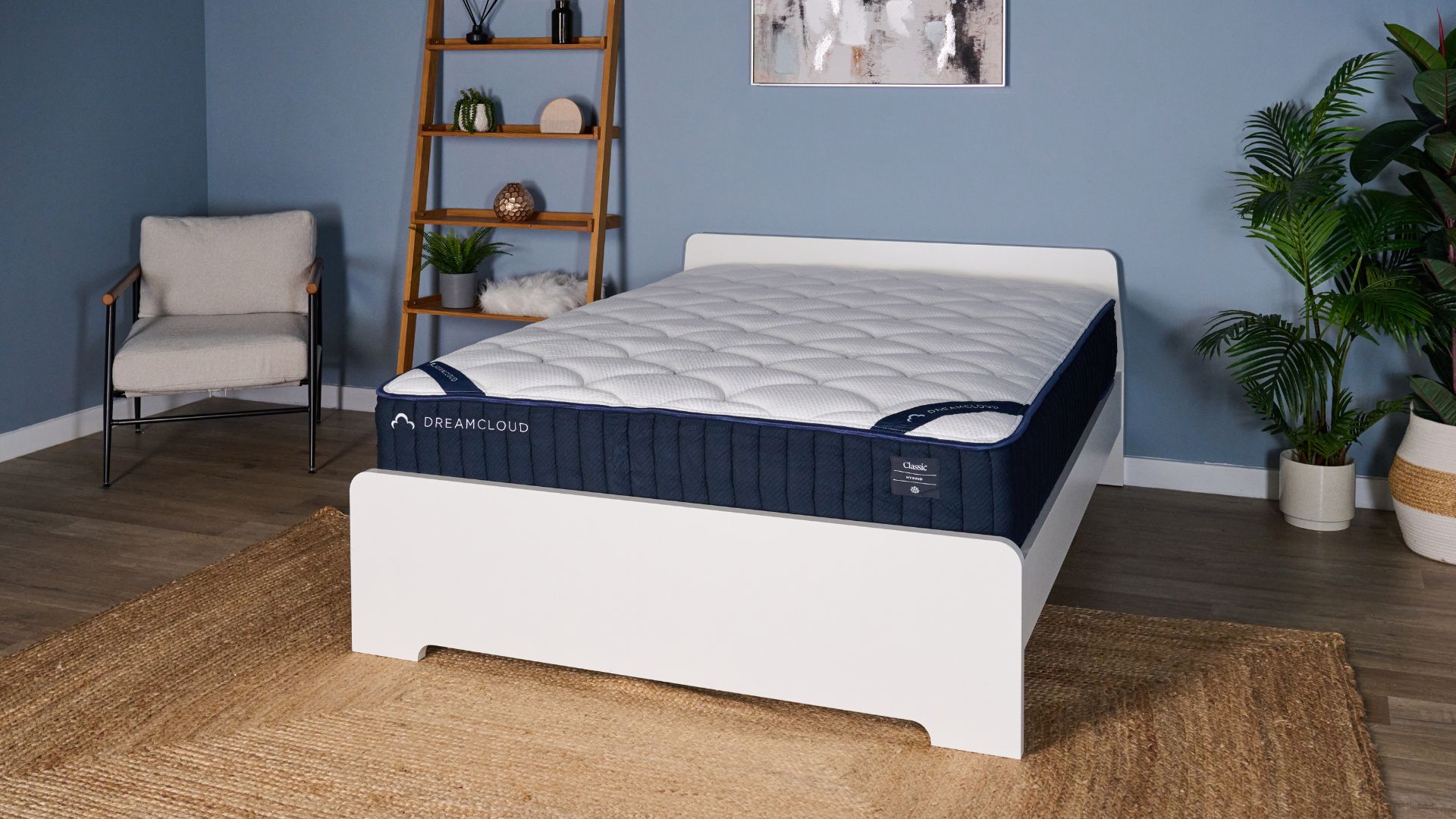
DreamCloud also has some of the best benefits on the market. A limited lifetime warranty protects you against faults (although note you should replace your mattress every 7-10 years) while the 365-night sleep trial allows you to test the bed in every season before making your decision. These extras are matched by sister brand Nectar but other than that, they're the kind of benefits we expect from premium mattress brands such as Saatva.
DreamCloud positions itself as affordable luxury so it's worth considering the price in terms of premium brands. While the DreamCloud doesn't quite live up to the quality and versatility of the Saatva Classic Mattress, it's far cheaper and a great alternative on a budget (the WinkBed Mattress is another premium comparison.)
Design
- A 12" mattress with five layers
- A mix of springs and contouring foams
- Breathable CloudQuilt cover
The DreamCloud Hybrid is this brand's cheapest and most straightforward mattress. There are two other mattresses in the range – both hybrids, but with slightly fancier designs (take brief look at how the three DreamCloud mattresses compare here).
The flagship model we're reviewing here is a 14-inch tall hybrid, made up of seven layers. At the base is an inch-tall foam base. Above that is a support coil layer consisting of 8.5-inch individually-wrapped springs that adapt to the contours of your body.
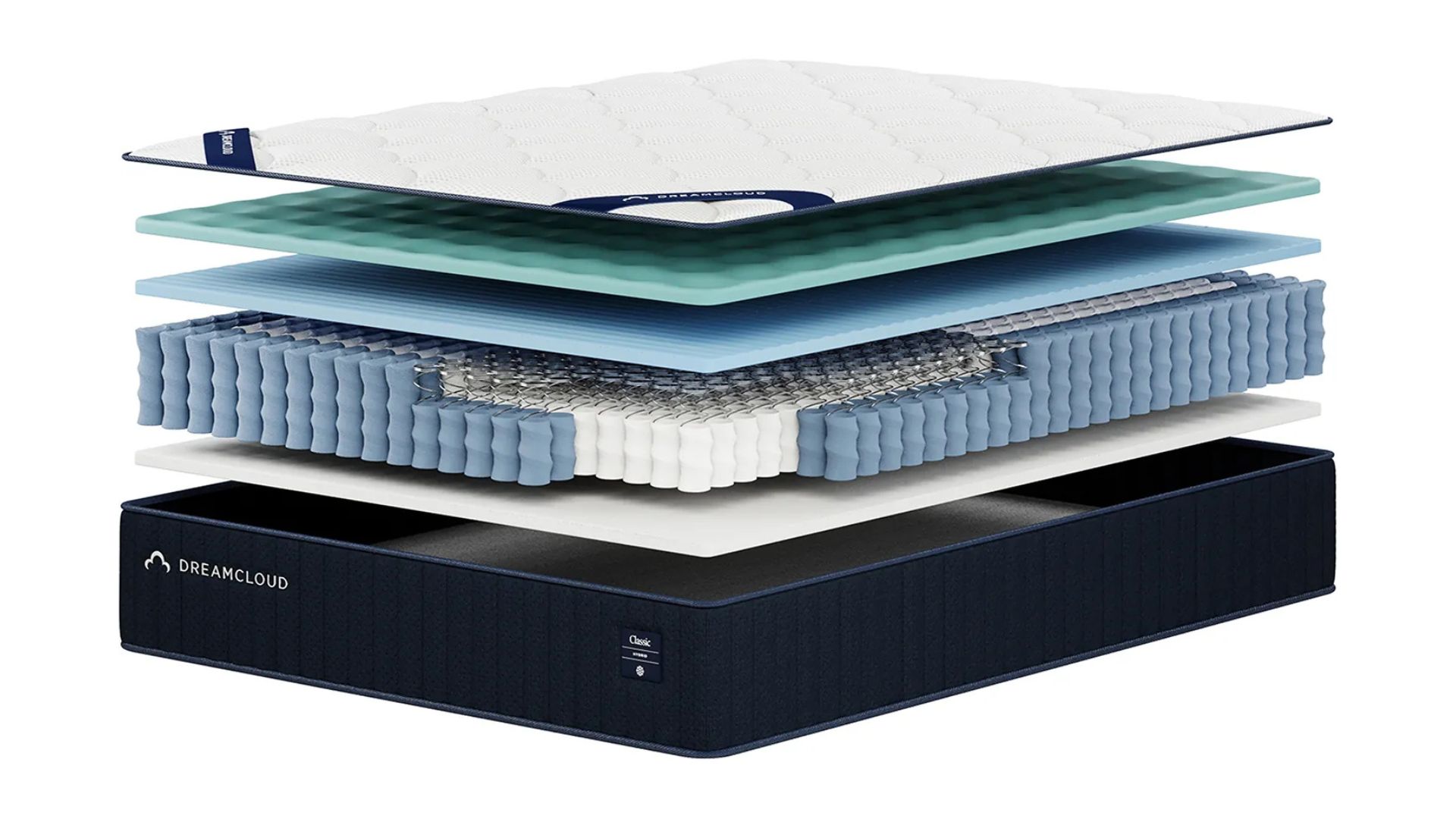
That's followed by two comfort layers (head to our mattress foam types explainer for more info). Directly above the coils is a responsive foam layer that adapts to your movements. Sitting on top of that is a therapeutic memory foam layer designed to contour around your body. Together, they're designed to provide cushioning and contouring, without trapping heat. All these foams are CertiPUR-US certified, which means they meet certain minimum health and environmental standards.
The whole thing is topped off with a CloudQuilt, breathable cover. It's not removable for washing, so we recommend you pick up one of the best mattress protectors to keep it in good shape. You can also spot treat the top cover for stains and spills – our guide on how to clean a mattress walks you through this.
Comfort: What it's like to sleep on
From the very first night, I was comfortable on the DreamCloud Classic mattress. As soon as I lay down, I felt the support elevating me, rather than letting me sink too far into the bed, despite the softer-than-expected feel.
The bed cushioned my body and the quilted cover relieved pressure at my hips, shoulders and knees. I noticed I woke less in the night because I wasn’t tossing and turning as much as on my previous firmer, latex mattress (the Birch Luxe). My colleague Ruth Jones felt the same, reporting that she found the mattress comfortable for all sleeping positions (although she did notice that her hips sank a little too much when stomach sleeping — a similar experience to me).
I much preferred the more responsive feel of the DreamCloud Classic to all-foam mattresses I’ve tested, like the Nectar Luxe. Now included in our best hybrid mattress of the year round up, the slight spring in the coils of the DreamCloud meant that changing positions was easy, although feeling my partner’s movements did take a bit of getting used to. Another bonus is how cool the bed felt — I didn’t overheat once. It’s certainly up there with the most comfortable mattresses I’ve slept on…
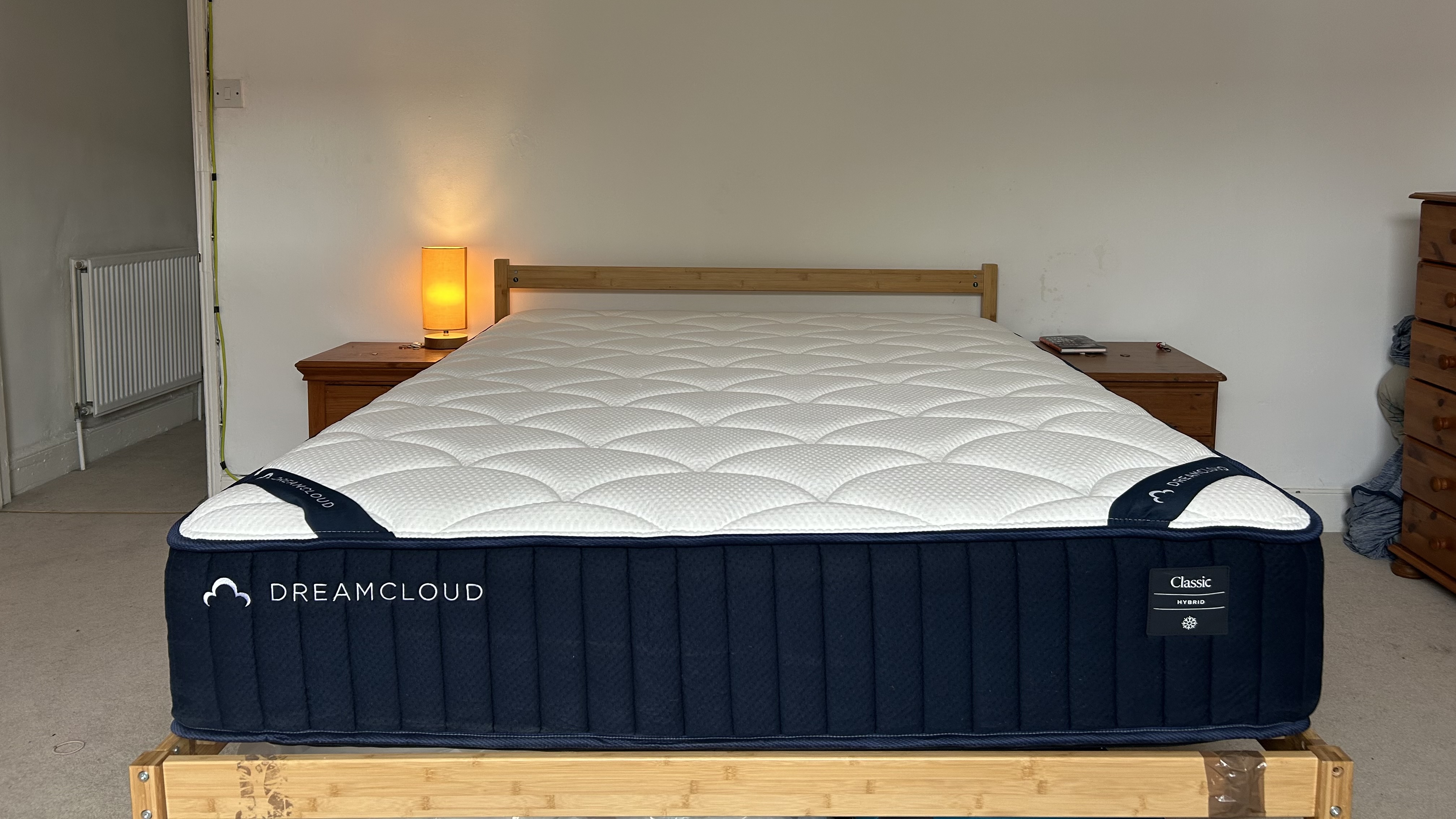
Temperature regulation: 3.5 out of 5
While the DreamCloud Classic doesn’t incorporate any specialist cooling features or materials like Glaciotex or copper foams, it does have an airy hybrid construction. This allows air to flow through the bed and cool it down (compared to more dense structures like all-foam beds). This proved enough for the mattress to regulate temperature throughout the night excellently.
To find out just how effective it was, we recorded the heat absorption and dissipation of the mattress over 30 minutes — the first 15 minutes having a Tom's Guide mattress tester lying on it.
Within the first minute, the camera recorded a 7.3 °F change in temperature when the tester lay on the bed, but that was the maximum temperature change we recorded. For context, during tests for the Bear Elite Hybrid mattress review — our best cooling mattress we've tested this year — absorbed a maximum of 10 °F, so it's an impressive that the DreamCloud had a lower maximum temperature increase.
However, it's important to note that the Bear Elite Hybrid is has specialist cooling tech which behaves very differently to mattresses like the DreamCloud. For example, where it took 6 minutes for the DreamCloud to return to its original temperature, the Bear Elite Hybrid shed its heat almost instantly, dropping to its original temperature in just 3 minutes, which is why we still recommend it to hot sleepers over any other mattress.


The thermal imagery camera showed that the DreamCloud kept the sleeper at an even temperature throughout the 15 minute testing period. After increasing in temperature by 7.3 °F in the first minute, at the end of the 15 minutes it had actually decreased to 6 °F — this shows that it consistently released the heat, rather than holding on to it.
Memory foam mattresses are more likely to hold onto their heat, and our tests on the Siena Signature mattress proved this. After absorbing 8.1 °F in the first minute of the test, the Siena continued to hold onto heat, reaching a maximum temperature increase of 9.8 °F at 15 minutes.
What slightly let the DreamCloud's temperature regulation down, was the slow cooling rate. This refers to how quickly the DreamCloud sheds heat after the tester left the mattress. Out of our top 5 mattresses, the DreamCloud had the slowest cooling rate, measuring at 1.12 °F per minute. As expected, the Bear Elite Hybrid outperforms the DreamCloud here with a cooling rate of 1.82°F per minute.
DreamCloud Classic: temperature regulation test results
The lower the maximum temperature increase (MTI), and the faster the cooling rate, the cooler you'll sleep
Maximum temperature increase
| Product | Value (°F) |
|---|---|
| Saatva Classic | 6.3 |
| DreamCloud Classic | 7.3 |
| Nectar Premier | 8.1 |
| Siena Signature | 9.8 |
| Bear Elite Hybrid | 10.5 |
Cooling rate
| Product | Value (°F/min) |
|---|---|
| Saatva Classic | 1.26 |
| DreamCloud Classic | 1.12 |
| Nectar Premier | 0.9 |
| Siena Signature | 1.52 |
| Bear Elite Hybrid | 1.82 |

So what does this mean? In high temperatures, the bed might struggle to keep a neutral temperature. But ultimately, you’re unlikely to overheat on this bed, and if you share your bed, we don’t expect you to be impacted by your partner’s body temperature because the bed won’t absorb and hold onto their heat. When I shared the DreamCloud Classic with my husband who runs hot, I didn’t once feel impacted by his temperature.
While our testing panel didn’t find the bed immediately cool-to-the-touch, they noted that it was temperature neutral — neither hot nor cold — and this felt comfortable. After I slept on this mattress for over three weeks, I was impressed by the feel. Not once did I wake feeling hot or stuffy — if anything, I was too cool during a UK season change, which I could remedy with the right bedding.
I'd still suggest those who experience hot flashes or severely overheat at night to consider a specialist cooling mattress, or even one of this year's best smart mattresses for adjustable temperature control. But for most, this mattress will be more than adequate.
How the DreamCloud Classic regulates heat versus its rivals
This shows how effectively our five top-rated mattresses absorbed, managed and dissipated heat during our temperature regulation test
| Timestamp (minutes) | Saatva Classic (°F) | DreamCloud Classic (°F) | Nectar Premier (°F) | Siena Signature (°F) | Bear Elite Hybrid (°F) |
|---|---|---|---|---|---|
| 0 | 0 | 0 | 0 | 0 | 0 |
| 1 | 3.5 | 7.3 | 8 | 8.1 | 8.2 |
| 2 | 6.3 | 7.1 | 8.1 | 8 | 9.5 |
| 3 | 5.5 | 6.9 | 6.76 | 8.6 | 9.2 |
| 4 | 5.4 | 7 | 5.6 | 8.4 | 9.3 |
| 5 | 4.6 | 7.1 | 5.7 | 8.1 | 9.8 |
| 6 | 4.6 | 7 | 5.3 | 8.6 | 8.9 |
| 7 | 5.8 | 7 | 5 | 9.2 | 9.3 |
| 8 | 5 | 6.2 | 6.2 | 8 | 10 |
| 9 | 5.4 | 6.5 | 7.4 | 8.4 | 10 |
| 10 | 5.5 | 6.7 | 6.4 | 7.9 | 9.6 |
| 11 | 5.1 | 6.1 | 6.2 | 8.3 | 9.4 |
| 12 | 4.8 | 6.5 | 5.9 | 8.2 | 9.3 |
| 13 | 4.7 | 6.5 | 6.1 | 9 | 9 |
| 14 | 5 | 6.7 | 6.3 | 9 | 10.1 |
| 15 | 5.2 | 6 | 6.6 | 9.8 | 10.5 |
| 16 | 5.3 | 3 | 3.9 | 3.6 | 3.3 |
| 17 | 2.3 | 2.3 | 2.8 | 3.4 | 1.1 |
| 18 | 1.4 | 1.5 | 1.9 | 3.1 | 0.2 |
| 19 | 1 | 1 | 2.3 | 2.2 | 1.2 |
| 20 | 0.8 | 0.4 | 2.1 | 2.2 | 1.4 |
| 21 | 0.5 | 0 | 1.6 | 2.3 | 0.2 |
| 22 | 0.4 | -0.4 | 2 | 1.6 | 0.2 |
| 23 | 0.3 | 0 | 2.1 | 1.8 | -0.3 |
| 24 | 0 | 0.2 | 2.5 | 2 | -0.4 |
| 25 | -0.9 | 0 | 2.4 | 1.8 | -0.1 |
| 26 | -1 | -0.7 | 1.4 | 2.1 | -0.7 |
| 27 | -1.2 | -0.7 | 1.6 | 2.1 | -0.8 |
| 28 | -1.3 | -0.6 | 1 | 2.1 | -0.7 |
| 29 | -0.5 | 0 | 1.1 | 0.4 | -1.3 |
| 30 | -0.6 | -0.3 | 0.3 | 1.5 | -1.1 |

Comfort and support: 4 out of 5
Pressure relief is one of the most important aspects of a mattress. Pressure points on our body usually occur when we're not properly supported at night, which leads to strain on certain joints and excess pressure building in areas of the body. Good mattresses can relieve and prevent this through comfort layers that cradle the body like foam, latex and wool. While coils or dense foam layers in the support core will help keep the body aligned throughout the night to encourage an even distribution of your body weight.
The DreamCloud Classic incorporates a therapeutic memory foam layer as well as an adaptive foam that responds to your body. Together, with 8" of individually wrapped coils, the mattress cushions your body while keeping you supported no matter your sleeping position, which results in excellent pressure relief.
Personally, as a side sleeper, I have found the DreamCloud incredibly comfortable. The softer feel means there was zero pressure around my shoulders, hips and knees throughout the whole three weeks of sleeping on it. While it doesn’t necessarily feel ‘contouring’ like a full foam mattresses, it certainly cushions — giving just the right amount to still feel like you’re sleeping on top of the mattress, rather than inside it.
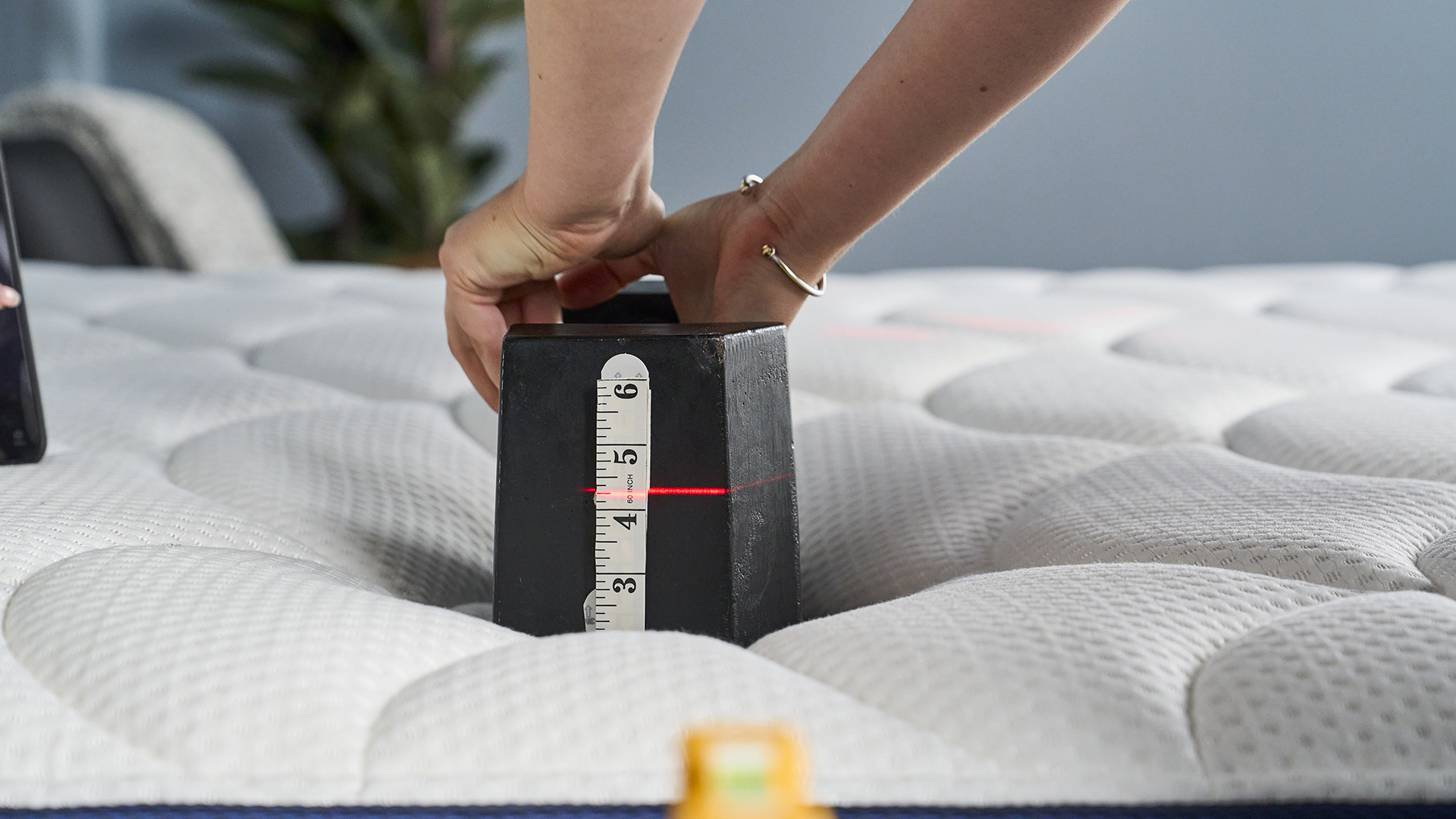
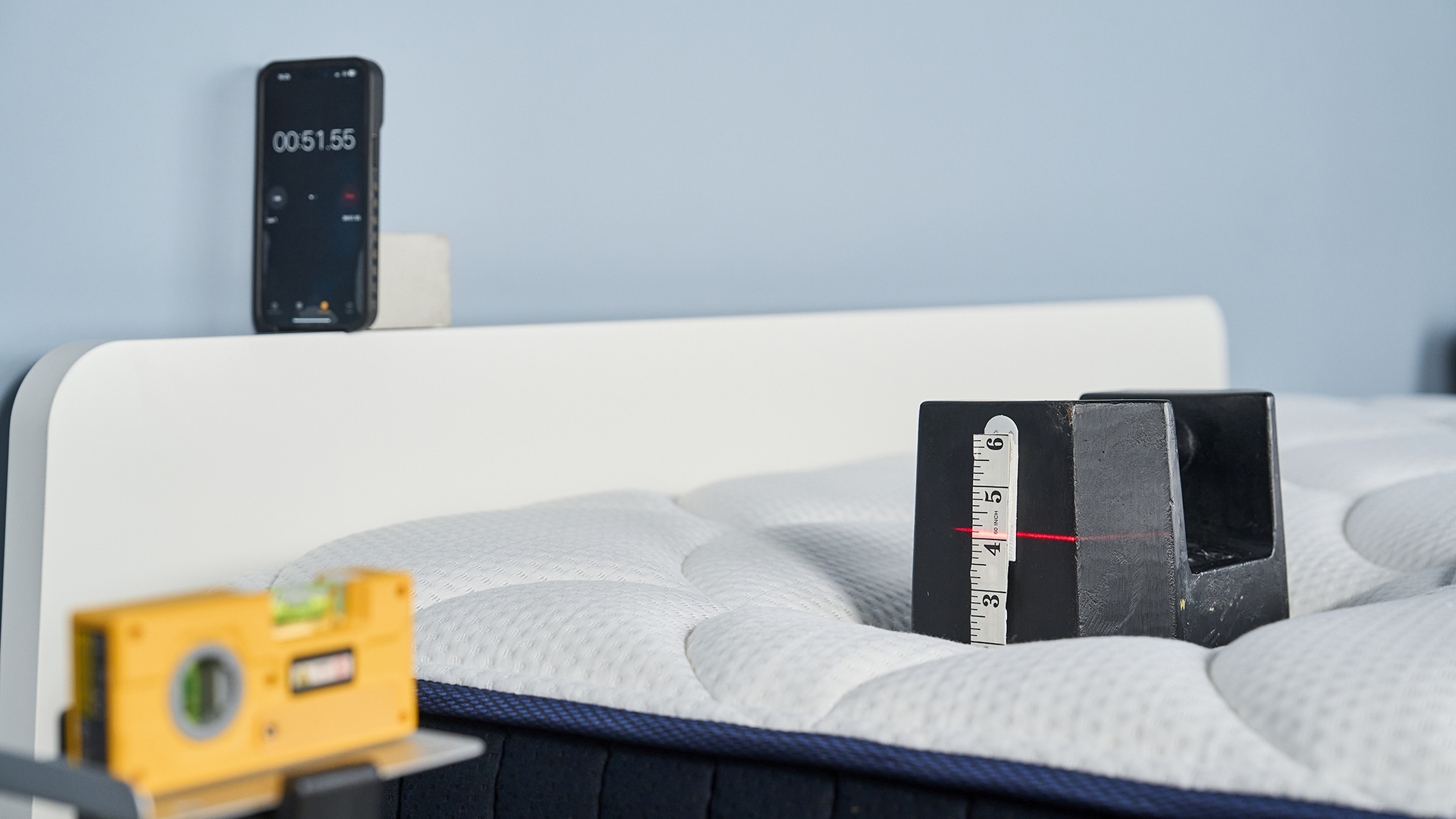
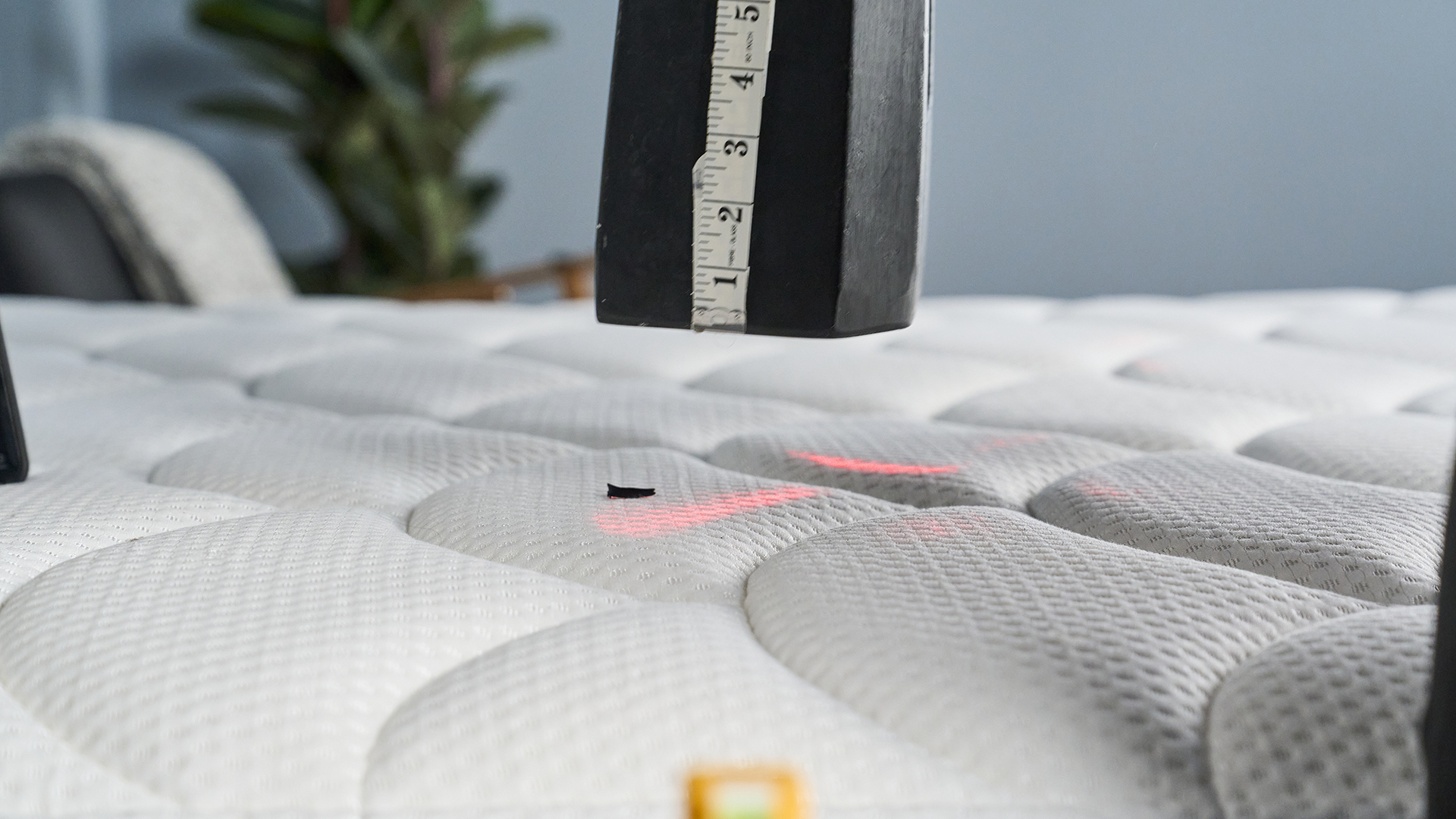
And our testing panel felt the same. In fact, Ruth Jones, a seasoned mattress tester and Sleep Writer, found that she felt comfortable instantly in every sleeping position. She did note slight pressure in her shoulders while lying on her side, but put this down to not having a pillow to support the weight of her head and not usually lying in that position — and she did note that this pressure faded after 10 minutes.
We tested just how good this pressure relief was by placing a 25kg weight where the shoulders would naturally sit and the hips, measuring the sink and how quickly the bed responded to the weight being lifted off.
After 5 minutes, the 25kg weight (which represents a third of the average American body weight) sank 4.25" at the shoulders and 4.5” at the hips, with an average sink of 4.37".
For context, the Siena Memory Foam mattress which has a firmer feel but excellent pressure relief sank 3.25 at the shoulders and 4” at the hips with a 25kg weight, which is a similar distribution to the DreamCloud. We were especially impressed with how quickly the DreamCloud responded to movement. It only took 2 seconds for it to return to its original height and shape once the 25kg weight was removed, and our testing panel noticed how easy it was to move around on the mattress, thanks to this responsive feel.
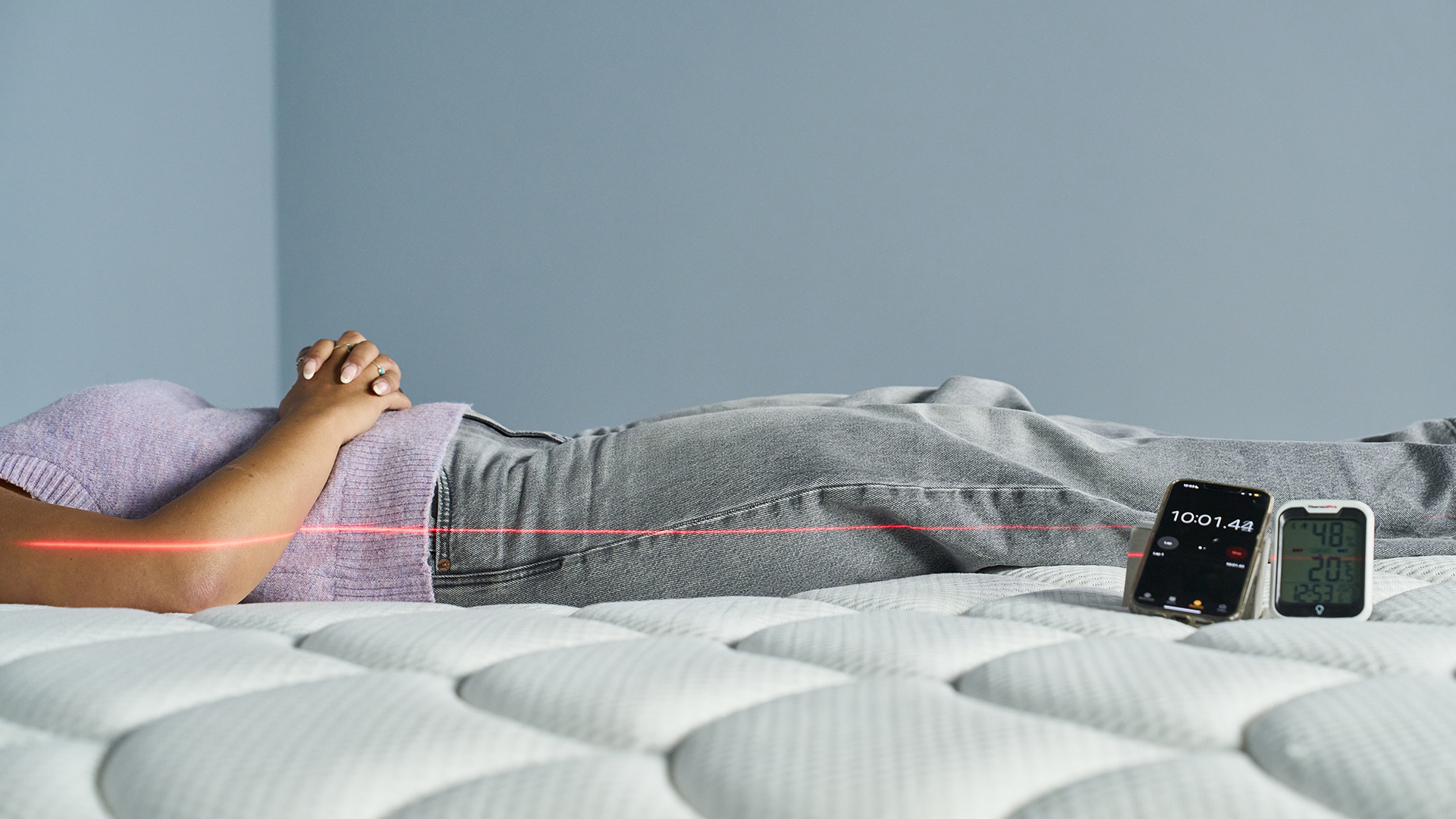
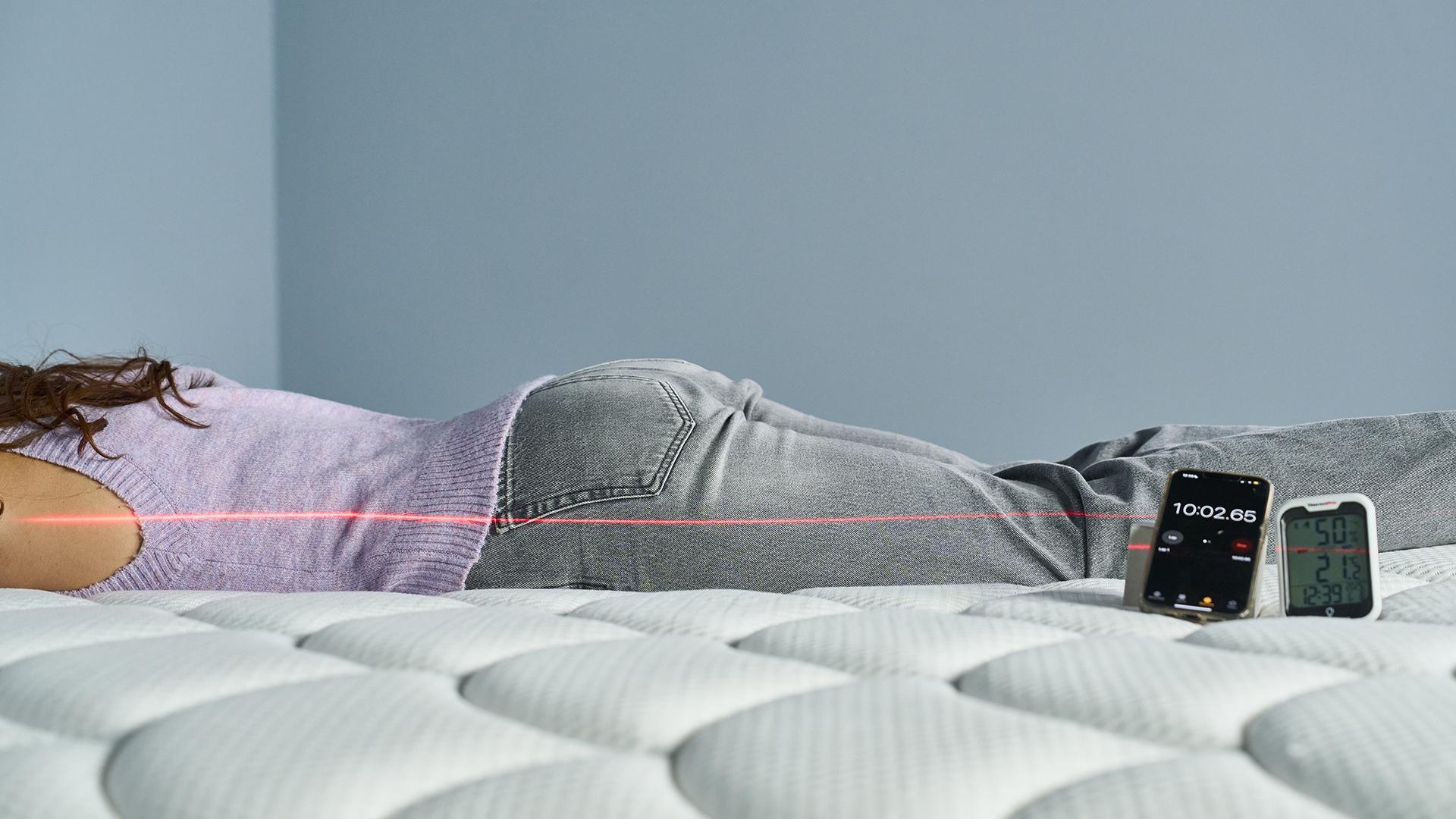
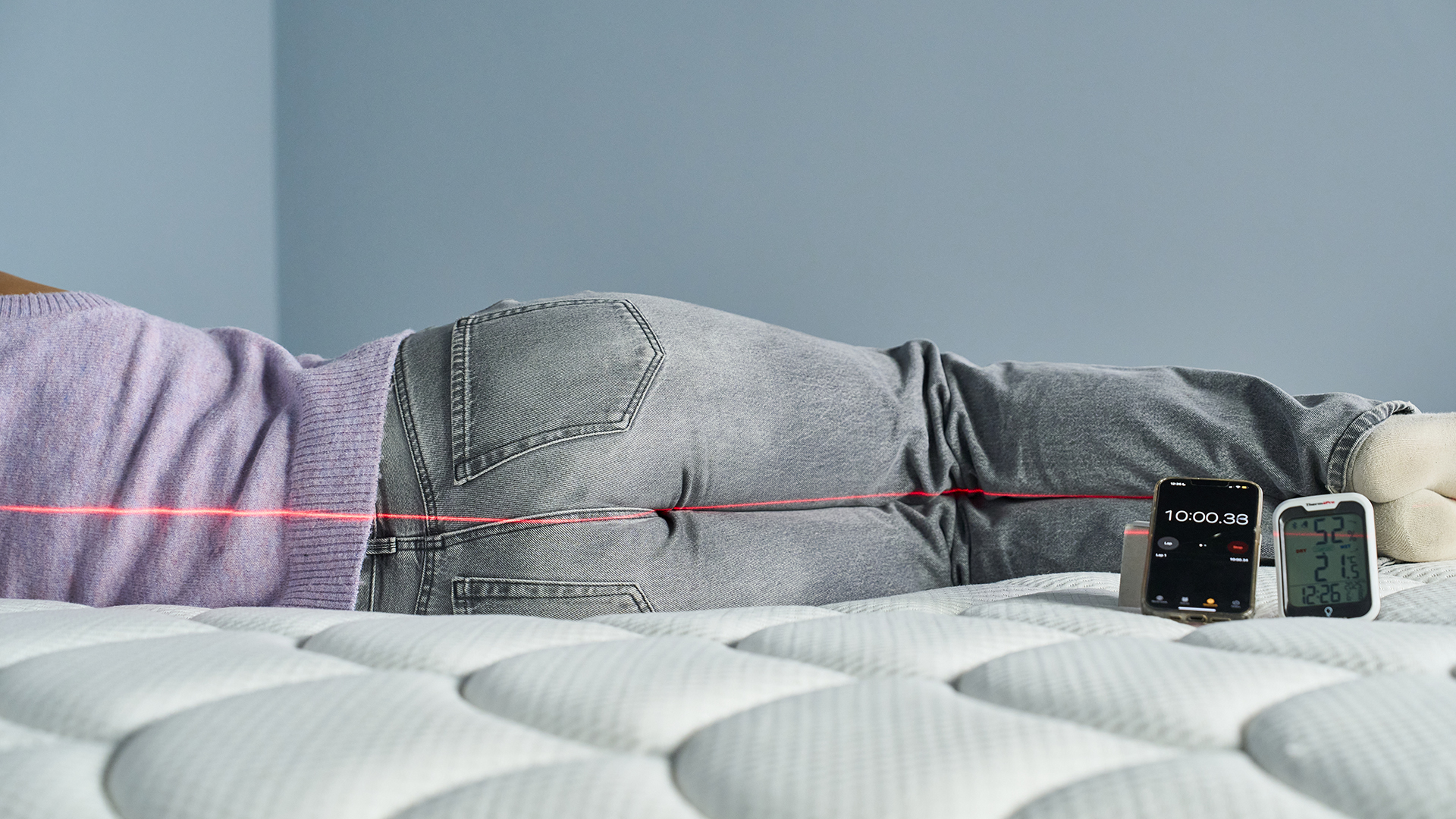
To measure alignment, we observed the curvature of the spine with a laser while our panel of testers lay for 15 minutes in each of the three major sleeping positions. Eve Davies, part of our testing panel and Staff Sleep Writer, found that during the test she felt the least pressure while on her back.
We noted perfect spinal alignment in this position, as well as side sleeping, although when Eve turned on to her front, there was a very slight but noticeable difference in her alignment as her hips sank into the bed. This was as expected, considering most of the feedback noted the bed to be too soft for stomach sleepers.
It is important to note that Claire Davies, Tom's Guide's Managing Sleep Editor, found that the DreamCloud sank beneath her too much in most sleeping positions, creating a hamocking effect. For this reason, it might not have enough pressure relief for heavier people to be fully supported throughout the night.
DreamCloud Classic: pressure relief test results
The deeper the indentation and faster the response time, the better the ability of a mattress to relieve pressure
Hip indentation (25kg)
| Product | Value (inches) |
|---|---|
| Saatva Classic | 4.75 |
| DreamCloud Classic | 4.5 |
| Nectar Premier | 4 |
| Siena Signature | 4 |
| Bear Elite Hybrid | 3.875 |
Shoulder indentation (25kg)
| Product | Value (inches) |
|---|---|
| Saatva Classic | 4.6 |
| DreamCloud Classic | 4.25 |
| Nectar Premier | 4.25 |
| Siena Signature | 3.25 |
| Bear Elite Hybrid | 4.5 |
Hip recovery time (25kg)
| Product | Value (seconds) |
|---|---|
| Saatva Classic | 0.1 |
| DreamCloud Classic | 2 |
| Nectar Premier | 5 |
| Siena Signature | 2 |
| Bear Elite Hybrid | 2.3 |
Shoulder recovery time (25kg)
| Product | Value (seconds) |
|---|---|
| Saatva Classic | 0.1 |
| DreamCloud Classic | 1 |
| Nectar Premier | 3.5 |
| Siena Signature | 1.5 |
| Bear Elite Hybrid | 1.95 |

Firmness
Mattress firmness is ultimately subjective. Some people might find a mattress super soft while to others the same bed will feel like sleeping on the floor. How a mattress feels depends on factors like your body weight, sleeping position and personal preference.
To help guide our readers, we measure the firmness of a mattress using a scale of 1-10 (1 being marshmallow, sink-in soft and 10 being as firm as a plank of wood). We determine this rating based on how much downward force it takes to make an indentation on the mattress, as well as collating subjective feedback from a panel of mattress testers which includes people of varying heights, weights and preferences.
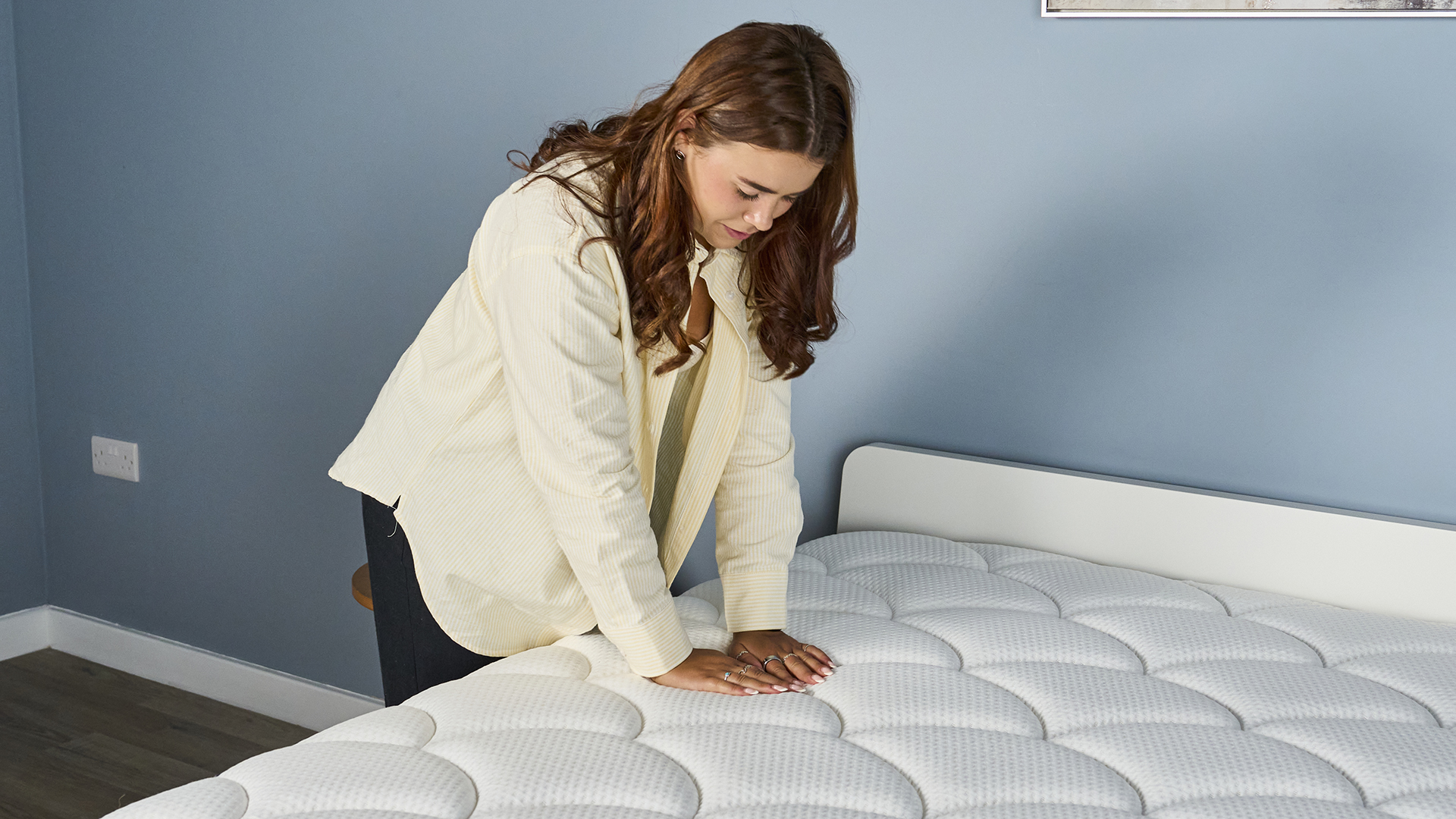
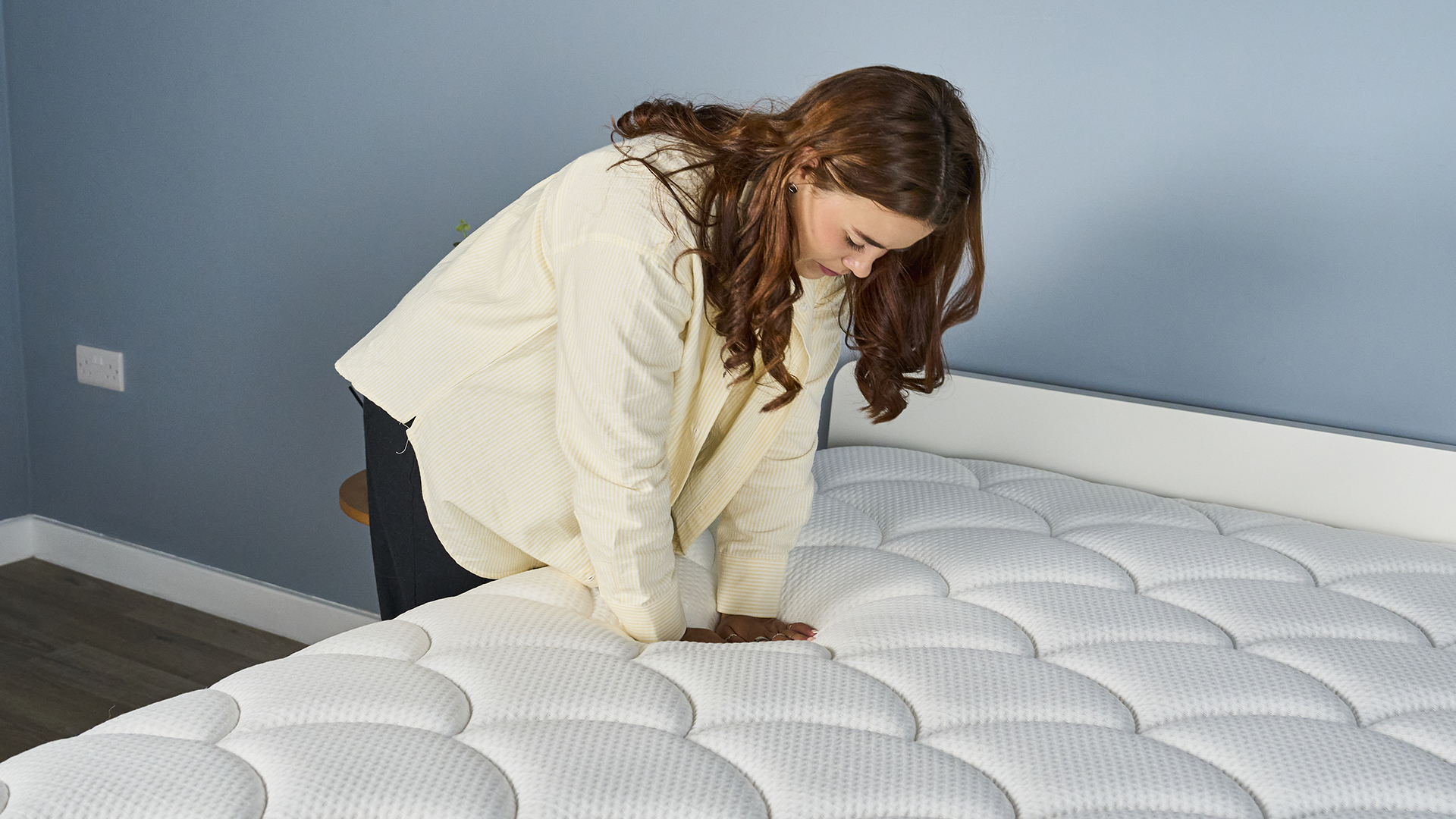
Our panel rated the DreamCloud as a six out of 10 which is softer than the brand's 'firm' rating. We found that you’ll feel some sink when you lie on the bed, cushioning your body, but you'll still feel elevated, rather than sinking too far into the mattress.
Our panel of testers found that this was most comfortable for back and side sleeping, where the lumbar region remained supported but the mattress sank beneath the hips and shoulders enough to relieve pressure. However, it was a little too soft for stomach sleepers, who found their hips sank too far into the mattress to keep the spine aligned. This lines up with what we saw during our spine curvature test.
It's important to note that while the DreamCloud has a 1,000lbs capacity, it will probably feel softer for heavier sleepers weighing over 250lbs.
Score: six out of 10
Motion isolation: 3.5 out of 5
Motion isolation refers to how well a mattress stops movement from traveling across the bed. So, as you can imagine, it’s an important consideration for bed sharers, whether you’ve got restless pets, a partner or fidgety kids.
Some mattresses, like the best memory foam mattresses we've tested, will absorb almost all motion — when I’ve slept on these before I haven’t even noticed my husband coming to bed. For example, during the Siena Signature mattress review testing (an all-foam bed) it scored 5 out of 5 for motion isolation, which is the best we've ever seen. However, hybrids will always fall behind on motion isolation, because the springs and coils are too responsive to completely isolate motion.
When our team tested the motion isolation of the DreamCloud Classic, the results were as expected. While I lay down and closed my eyes and my colleague got onto the bed, tossing and turning, I could feel every movement — she reported the same when I started moving.
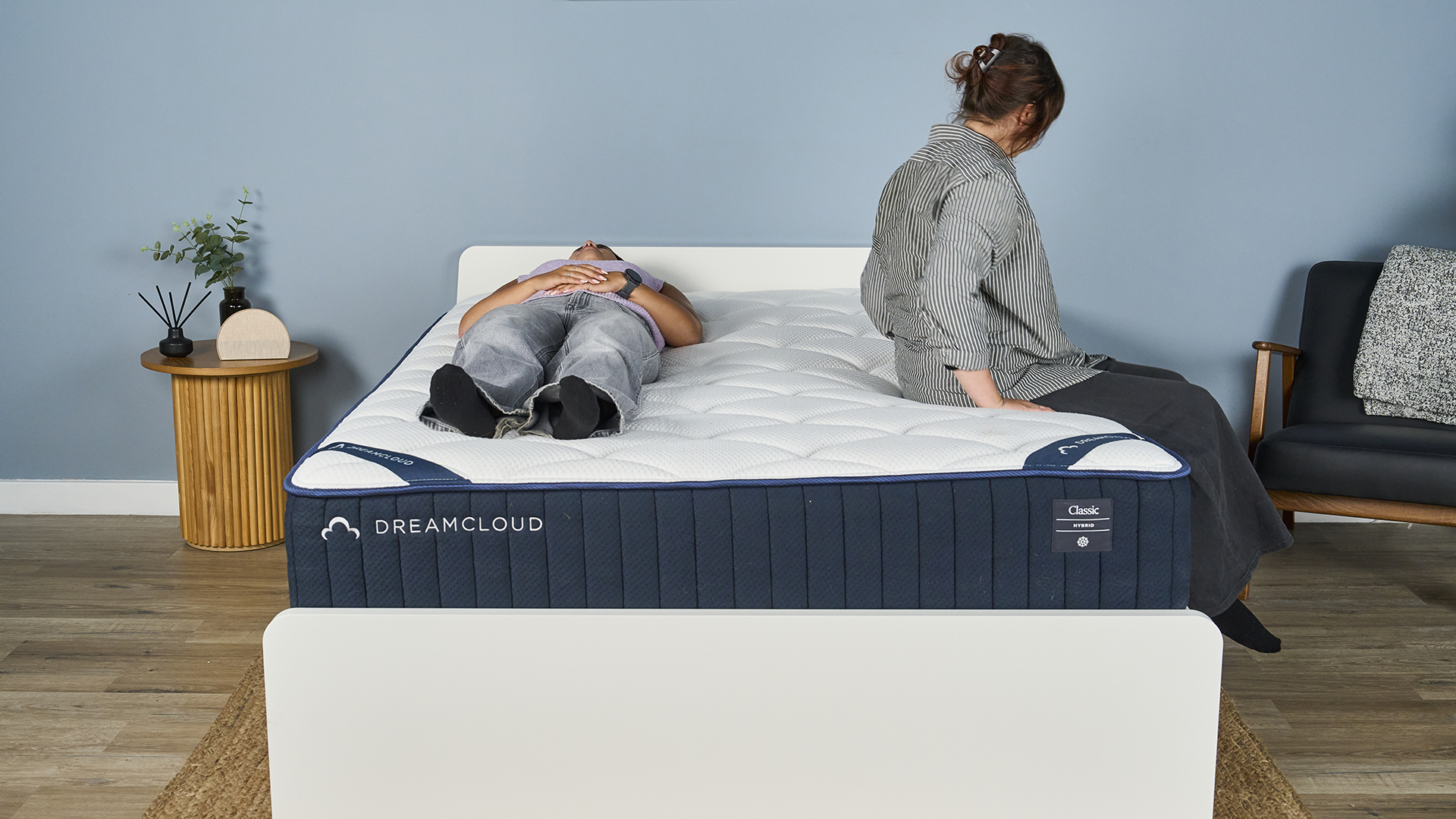
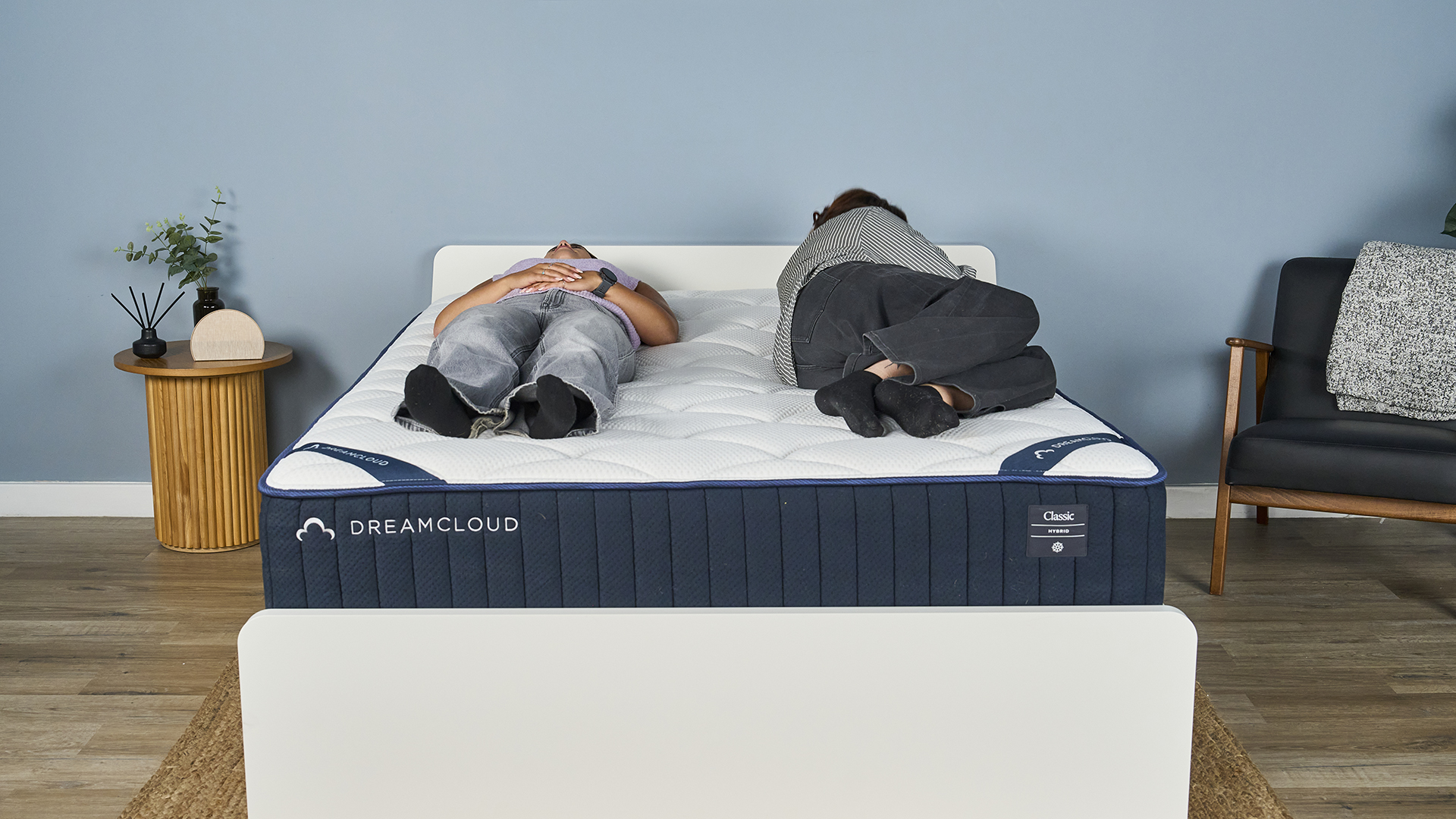
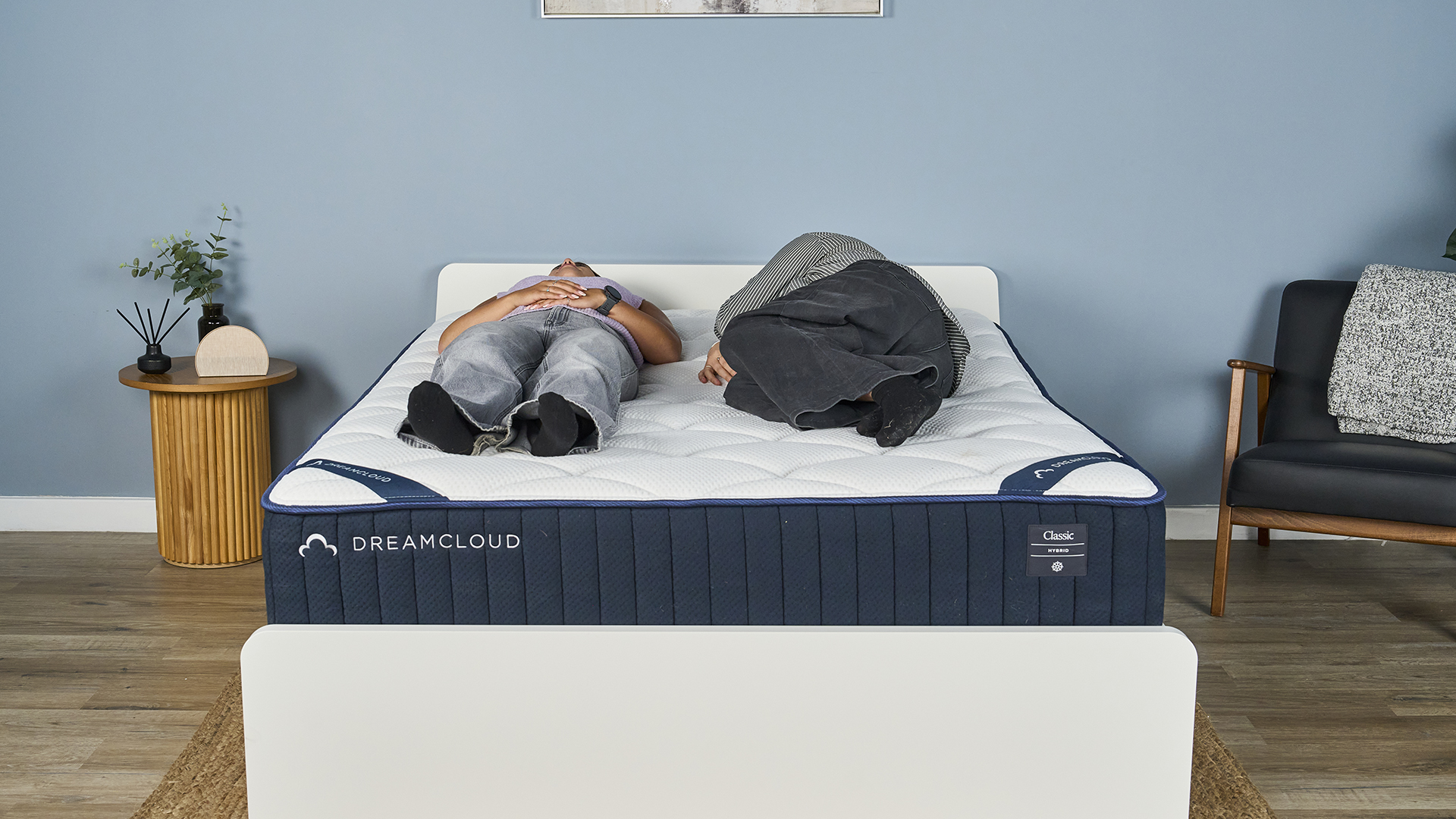
During our lab tests, we dropped a 5kg slam ball onto the bed from a height of 24" to replicate a real-world scenario of a sudden, concentrated impact on a mattress, such as a person getting into bed, a pet jumping on the mattress, or a partner shifting into a new sleeping position.
We then measured the impact absorption of the slam ball using an accelerometer and how long it took for the motion to stop. We recorded a 7.96 m/s2 initial impact absorption (IIA) and an average decay rate (how long it took for the motion to stop) at 3.22 seconds.
In comparison, and as we reported in our Saatva Classic mattress review, the Saatva, which has a similar hybrid structure to the DreamCloud but is a more luxury bed, had a 7.86 m/s2 IAA, which is almost the exact same as the DreamCloud.
However, Saatva's decay rate was much lower at 1.7 seconds. Ultimately, that means while both mattresses absorb around the same amount of motion, the Saatva stops that motion from traveling across the bed much more quickly, and therefore, more effectively, than the DreamCloud.
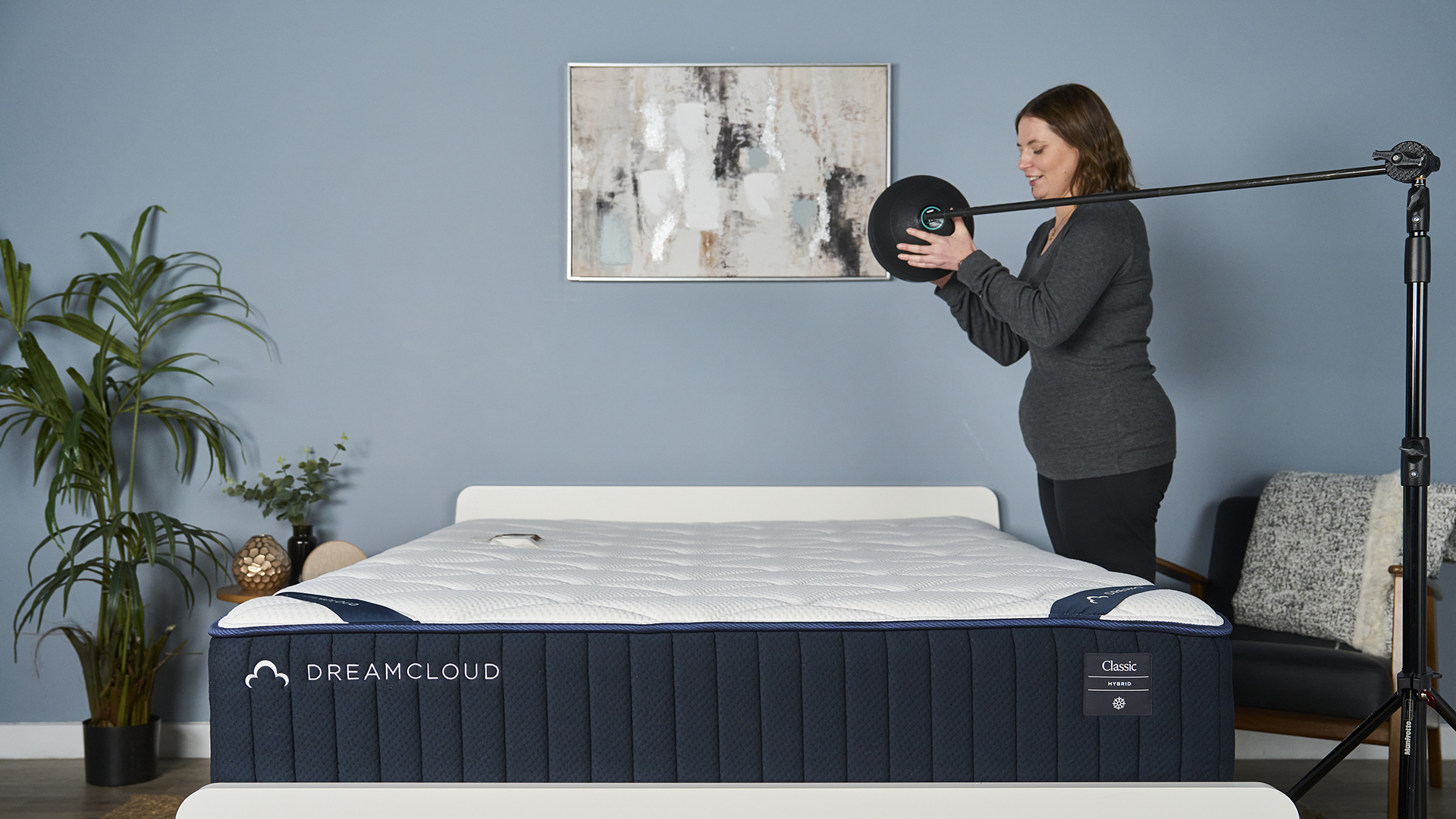
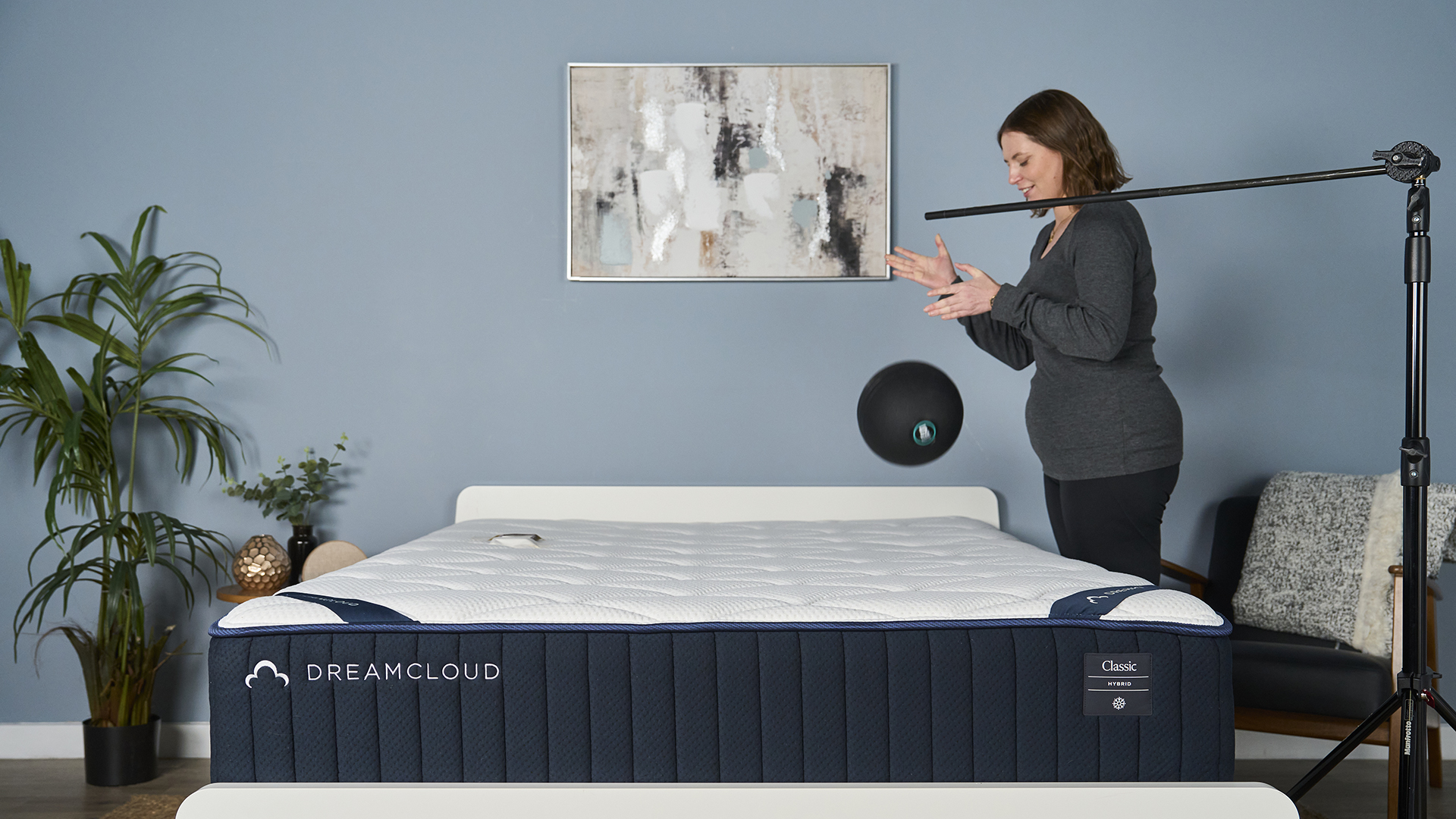

So, when I took the mattress home, I was expecting my husband's movements to keep me awake (we have different schedules and he often comes to bed later than me). While I did notice his movements when I was awake, they weren’t significant enough to wake me up when I was asleep. However, if you were a lighter sleeper, I imagine you might be disturbed (especially if you share a bed with your children).
Ultimately, I think it's unlikely the motion isolation will cause real sleep problems. But if you do share your bed with particularly fidgety bodies, it's probably worth investing in a memory foam mattress, like the Siena Signature, which received the best motion isolation score we've ever awarded at 4.5 out of 5.
DreamCloud Classic: motion isolation test results
The lower the initial impact of the ball, the better the mattress is at dampening the original force, meaning there's less motion to transfer
Initial impact
| Product | Value (m/s2) |
|---|---|
| Siena Signature | 5.527 |
| Saatva Classic | 7.863 |
| Nectar Premier | 7.961 |
| DreamCloud Classic | 7.965 |
| Bear Elite Hybrid | 8.976 |
Decay rate
| Product | Value (seconds) |
|---|---|
| Siena Signature | 1.14 |
| Saatva Classic | 1.703 |
| Nectar Premier | 2.546 |
| DreamCloud Classic | 3.22 |
| Bear Elite Hybrid | 3.504 |

Edge support: 4 out of 5
Edge support refers to how stable the perimeter of the mattress is. If the edges collapse or sink more than the middle of the mattress, we’d generally consider that weaker edge support. However, if the edges have the same firmness and support as the middle of the mattress, that proves excellent edge support.
For people who sleep up against the sides of a mattress, elderly people who find it hard to get in or out of bed or those who rely on the edges of a bed to get ready in the mornings, it’s an important feature. Generally speaking, hybrid mattresses with reinforced edges perform best — although the best edge support I’ve felt has actually been from the Nectar Luxe, which is an all memory foam mattresses.
The DreamCloud does have a reinforced edge, which means separate coils run around the perimeter of the mattress to keep it more stable, so we had high hopes before testing — and we weren’t disappointed. When we sat and lay on the sides of the bed, we felt supported enough to comfortably sleep up to the edge night long.
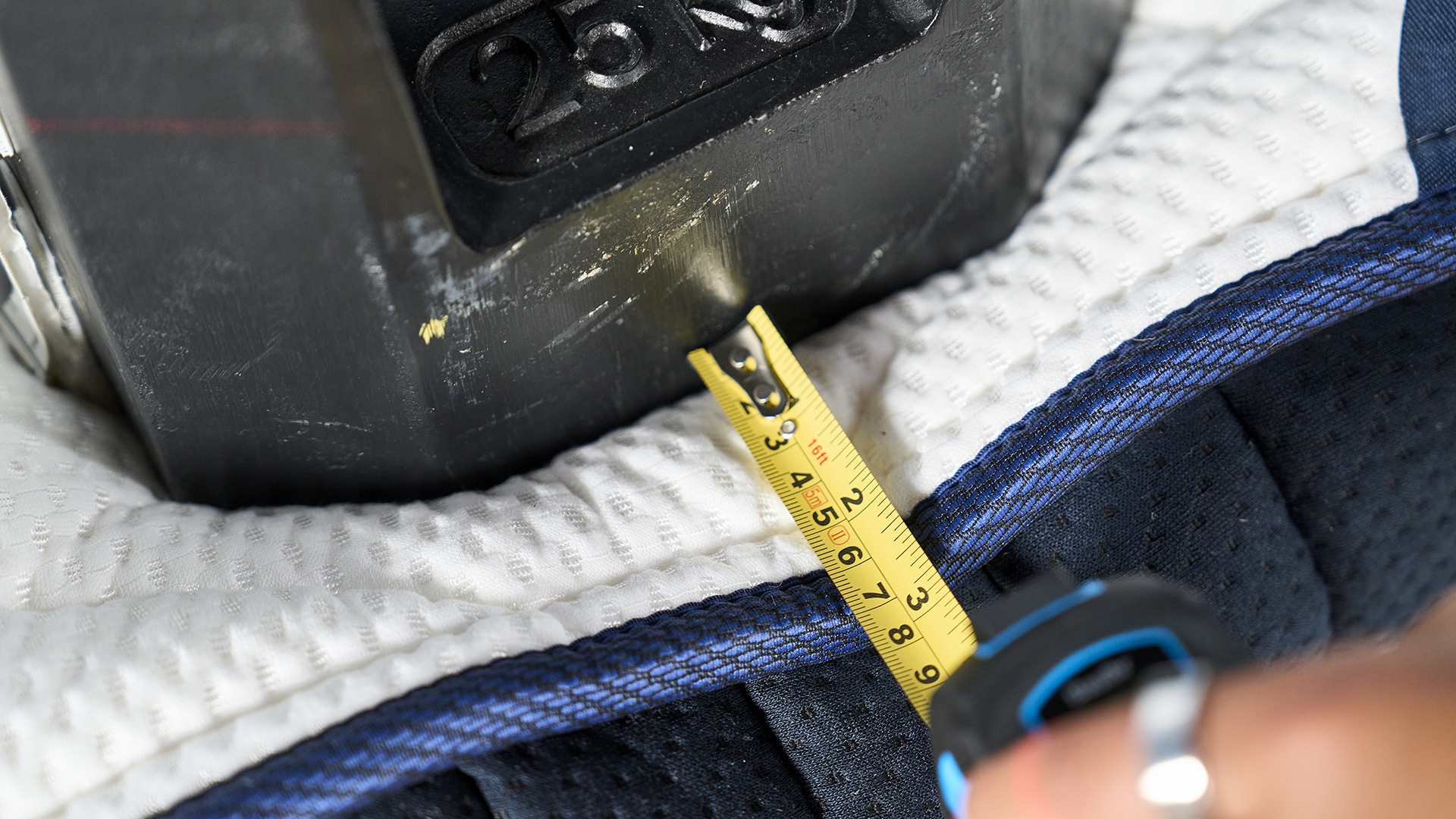
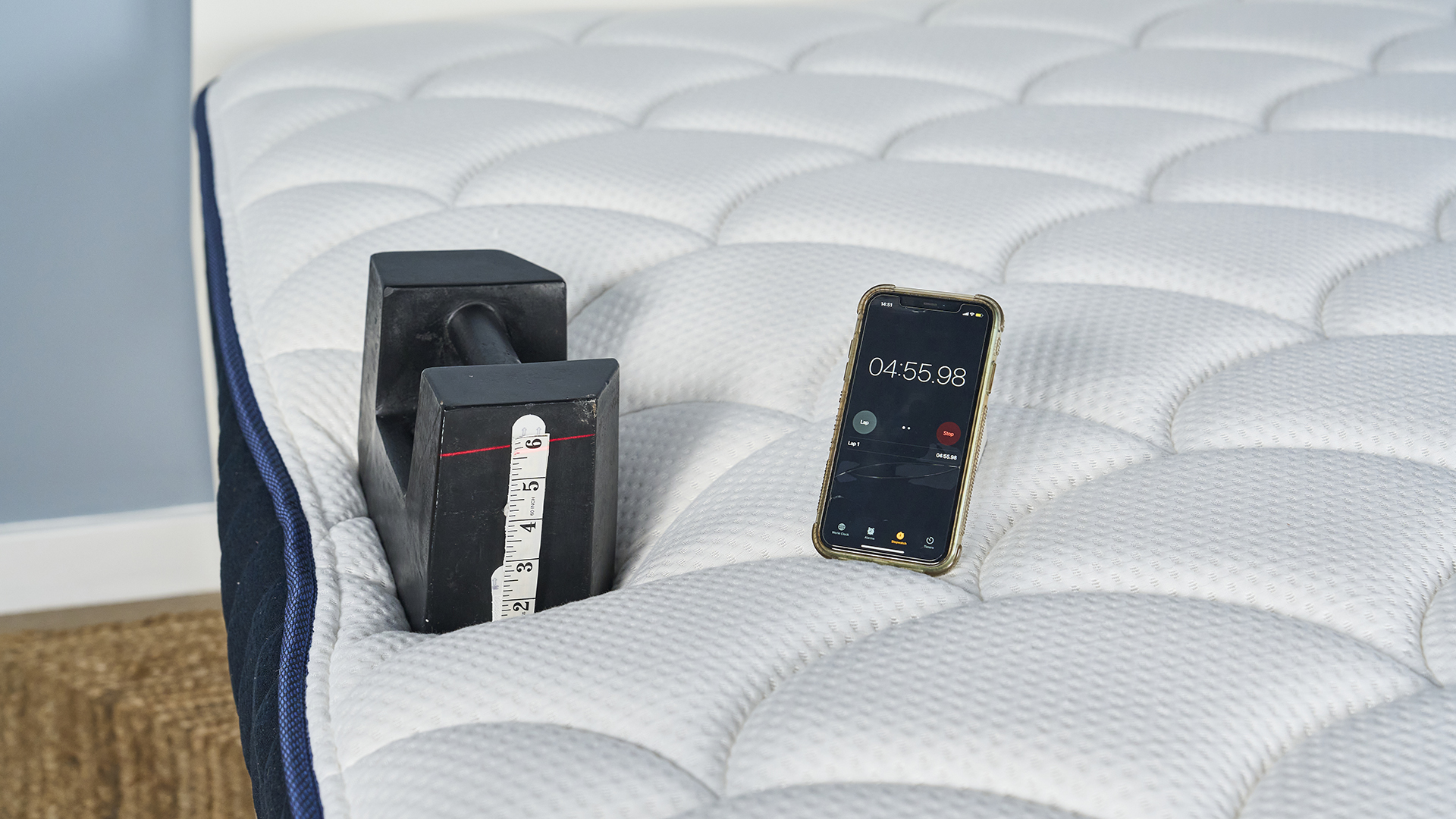
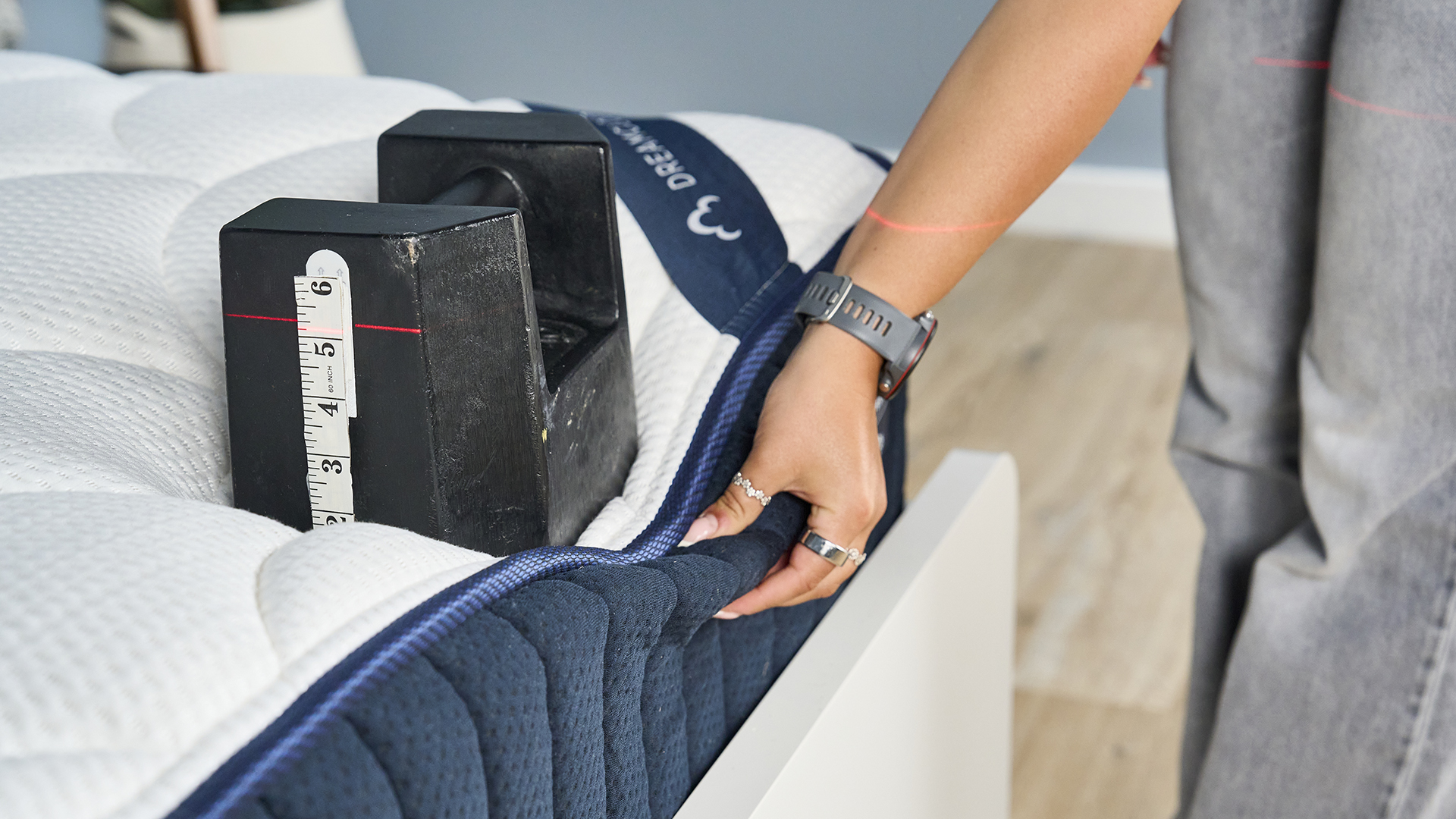
When I put it to the test at home, I slept comfortably right up against the edge throughout the night. I also found sitting on the edge of the bed to get ready felt stable. Not once did it feel as if I’d fall off the bed or that the mattress would collapse beneath me.
During our lab tests, we placed a 25kg weight 3" away from the side of the mattress to see how it would fair. It only sank 1" more than the middle of the bed, to a maximum compression of 5.5"
We did the same at the foot of the bed and recorded a maximum compression of 5.125". — which means the foot of the bed is more supportive than the sides. While it’s not necessarily the best edge support we’ve seen (during the tests on the Saatva Classic the weight only sank 0.4” more at the edges compared to the middle, scoring 5 out of 5), it’ll be more than supportive enough for most people.
DreamCloud Classic: edge support test results
Less compression means better support for climbing in or out of bed
Compression at foot of bed
| Product | Value (inches) |
|---|---|
| Siena Signature | 3.06 |
| Saatva Classic | 3.625 |
| Nectar Premier | 4.625 |
| DreamCloud Classic | 5.125 |
Compression at side of bed
| Product | Value (inches) |
|---|---|
| Siena Signature | 3.125 |
| Saatva Classic | 4.375 |
| Nectar Premier | 4.25 |
| DreamCloud Classic | 5.5 |

User reviews
- Rated 4.6 out of 5 stars, but reviews aren't separated by model
- Pros include cooling, durability, and excellent customer support
- Some sleepers find it too firm or soft, leading to aches and pains
One person's experience with a mattress will vary from another's based on height, weight, sleeping position, ideal temperature, and any aches and pains. Our testing panel is comprised of individuals with varying builds and quirks — but it's still a small sample size. To provide you with a more well-rounded perspective, we've also analyzed thousands of user reviews from verified DreamCloud customers.
As of November 2025, the DreamCloud has a user rating of 4.6 out of 5 stars, generated from over 9,000 reviews. Satisfied sleepers like the DreamCloud's keen balance of softness and firmness, exceptional temperature regulation, and durable build. The brand's customer support team also scores highly for their attentive service and prompt responses to queries.
Those who aren't happy with the DreamCloud Classic either say it's too firm or too soft. These are subjective assessments based on an individual's preferences, body type, and health issues, and likely a primary reason why DreamCloud provides a one-year trial period.
Should you buy it?
Ultimately, this is aone of the best hotel mattresses for exceptional value. While its temperature regulation (3.5 out of 5) and motion isolation (3.5 out of 5) doesn’t quite compare to its more expensive competitors like the Saatva, its pressure relief (4 out of 5) and edge support (4 out of 5) are just as impressive as some of this year's best luxury mattresses we’ve tested. But most importantly, its 5 out of 5 value for money is what makes this mattress really stand out.
Side sleepers will certainly benefit from the medium feel and will find the careful balance of softer foams and robust coils offer the perfect amount of ‘give’ while remaining supportive.
Similarly, back sleepers will feel their lumbar area supported, the softer, quilted top filling in the curves of the spine to take strain and pressure off the back. Although, if you're a heavier sleeper, you might not feel enough pressure relief as some of our testing panel experienced a hamocking effect.
Couples and hot sleepers will benefit from how cool this mattress stays throughout the night. The only people who I’d potentially warn away from the DreamCloud are those who sleep on their stomach. It’s just a little too soft to keep the spine aligned in this position.
My top alternative suggestion would be the Saatva Classic if you have a bigger budget to accommodate a more luxury purchase. The slightly firmer feel and zoned lumbar support means that even stomach sleepers will find this mattress comfortable. Check out our Saatva Classic review to see if it's worth the splurge.
If you’re working with a smaller budget, I’d suggest considering the Siena Signature mattress, rated as one of the best mattresses for stomach sleepers. With better temperature regulation (a cooling rate of 0.62 per minute compared to DreamCloud's 0.42 °F) and a firmer feel (rated at 8 out of 10), those who need to be more elevated — either on their back or stomach — will benefit from this great value bed. Take a look at our Siena Memory Foam mattress review to find out more.
It goes without saying that the DreamCloud Classic offers fantastic value for money. The Black Friday mattress deals make it a great time to invest in your sleep, and the DreamCloud Black Friday sale is now live, offering $599 of free bedding with your mattress.
Alternatives
1. Saatva Classic Mattress
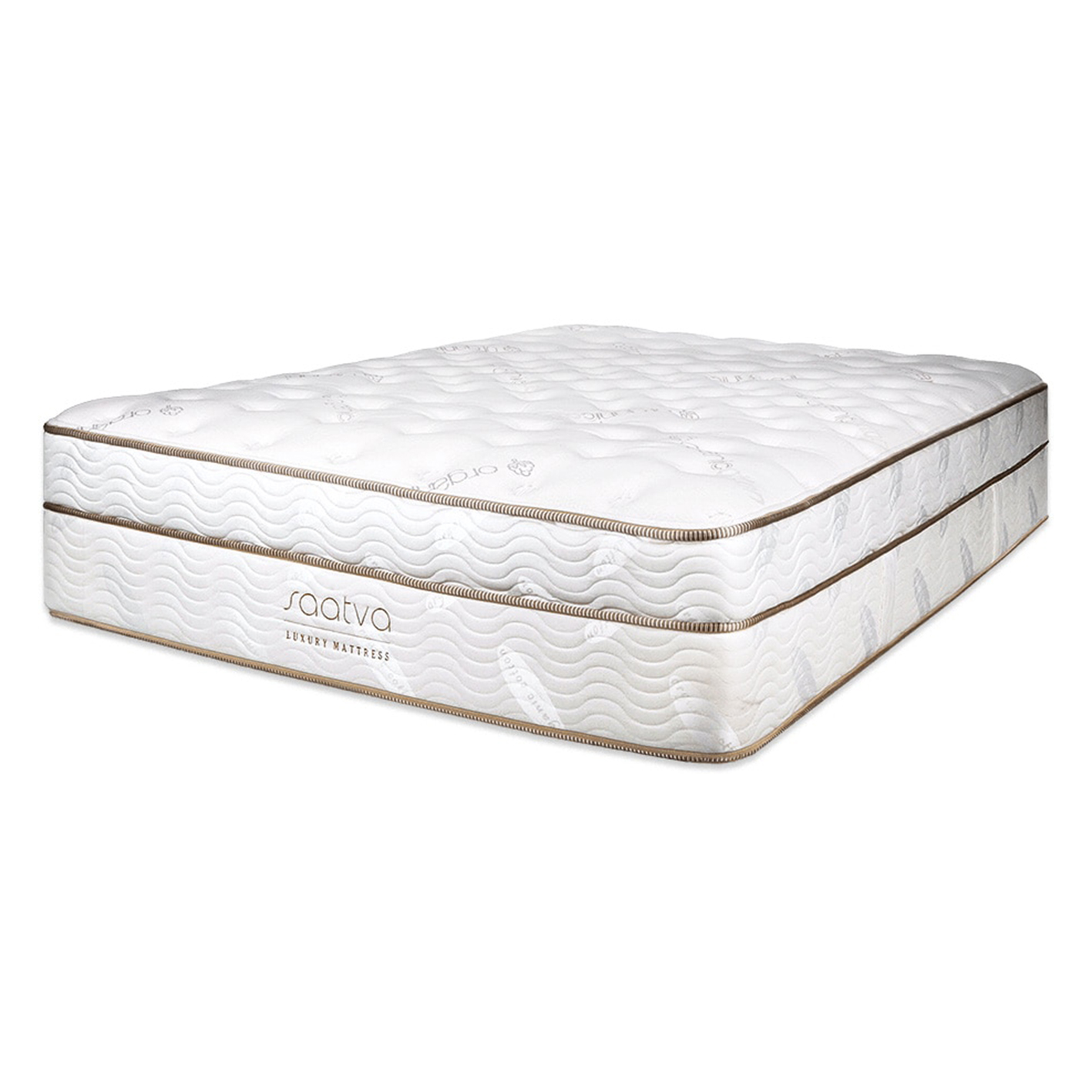
Type: Luxury hybrid
Firmness (1-10): Soft (3), Luxury firm (5-7), Firm (8)
Materials: Foam and innersprings
Height: 11.5 or 14 inches
MSRP: $1,399 - $2,998
Trial/Warranty: 1 year/lifetime
DreamCloud vs Saatva is a common match-up when it comes to luxury hybrids. Both beds are on the affordable end of the price scale (though Saatva costs more) and offer sufficient relief for sleepers who suffer from back pain and hot flashes. Each mattress also comes with generous 1-year risk-free home trials and a forever warranty.
However, the Saatva Classic has the advantage when it comes to tailoring a mattress to suit your needs as you can choose from three levels of firmness plus two heights. Plus, there's stress-free set-up with free white-glove delivery straight to your bedroom along with removal of your old mattress at no charge. The brand does charge a $99 returns fee though. With a feel that's reminiscent of beds found at 5-star hotels, the Saatva Classic is a top-tier mattress for sleepers of all stripes.
Choose Saatva if: you want to customize your mattress for ideal comfort
Avoid it if: you need a cheaper option
2. WinkBed Mattress
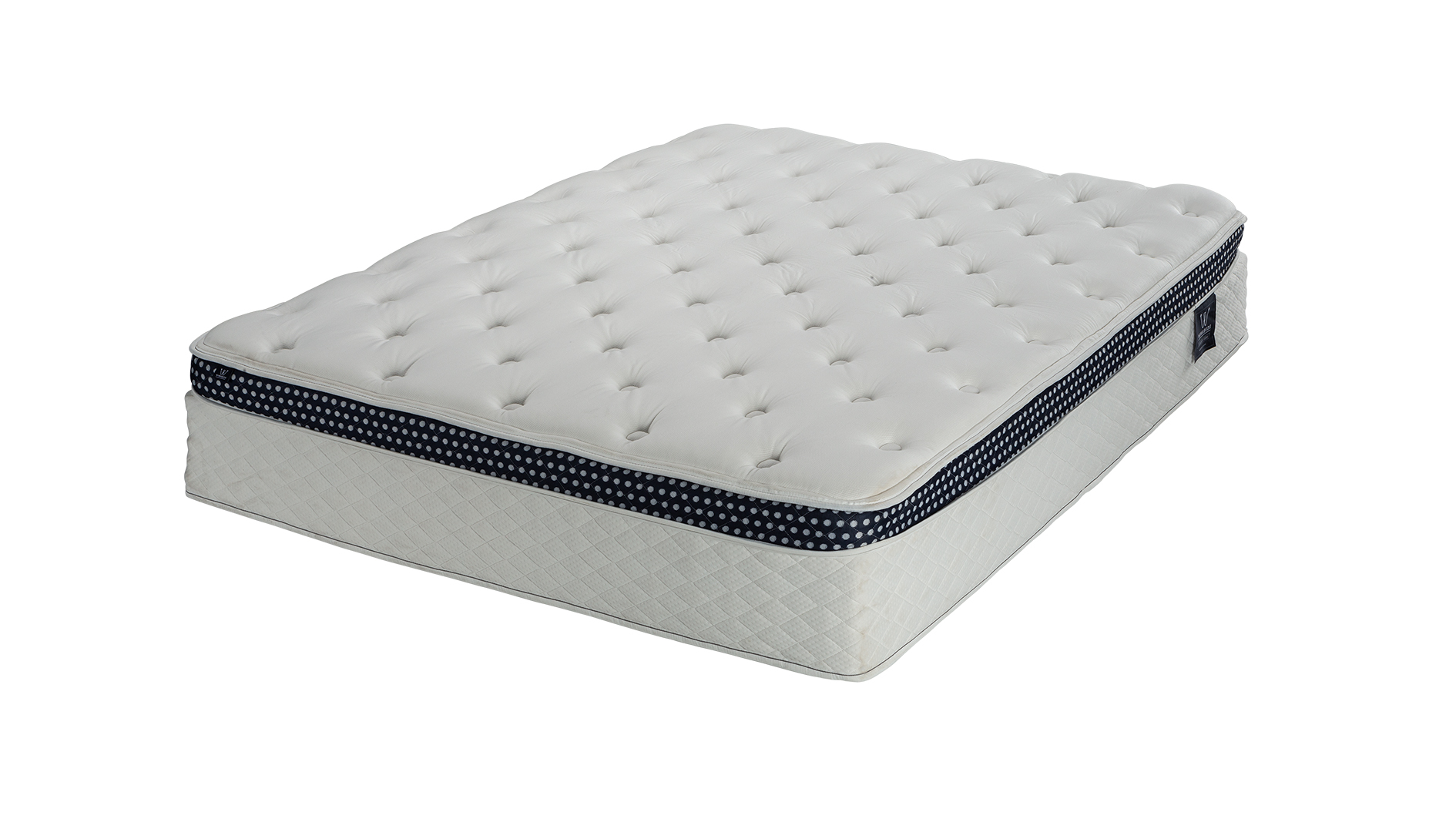
Type: Luxury hybrid bed-in-a-box
Firmness (1-10): 4.5 - 8 (soft, luxury firm, firm, plus for heavier bodies)
Materials: Foam and innersprings
Height: 13.5 inches
MSRP: $1,149 - $2,049
Trial/Warranty: 120 nights/lifetime
The WinkBed is another competitively-priced luxury hybrid mattress. It stands out for its four firmness levels — from a super-plush bed to a firm model made specifically for larger-framed individuals. Overweight sleepers (250lbs and over) might find the WinkBed's firmest option lends more stable support than the DreamCloud's lone medium-firm-to-firm offering.
Just like the DreamCloud, WinkBed includes a lifetime warranty with purchase. However, the WinkBed's trial period is only 120 nights — which is by no means meagre, but DreamCloud provides a full year to test its mattress. However, the trade-off in choosing the WinkBed is the ability to select a firmness that best suits your sleep style and build.
Choose WinkBeds if: you have a heavier body and/or want flexibility in firmness
Avoid it if: you want a longer at-home trial period
3. Nectar Classic Memory Foam Mattress

Type: Bed-in-a-box
Firmness (1-10): 6.5
Materials: Memory foam
Height: 12 inches
Sale price: $348 - $1,098
Trial/Warranty: 365 nights/lifetime
DreamCloud vs Nectar may not be a matchup that makes sense at first — we're pitting a luxury hybrid against a full foam mattress here. But Nectar's original memory foam model will appeal to sleepers who want more of that 'sink-in' feeling. Lightweight sleepers may also prefer the Nectar to the DreamCloud as the firmness of the latter won't immediately adapt to the contours of their body.
DreamCloud and Nectar are part of the same parent company (Resident); thus, Nectar also offers a 365-night trial plus lifetime warranty at a competitive price (and an evergreen up to 50% off sale). For a memory foam mattress, the Nectar has good temperature regulation, but we think very hot sleepers might find more relief with the hybrid DreamCloud and its breathable cashmere-blend top cover.
Choose Nectar if: you're a lightweight sleeper and/or like sinking into a mattress
Avoid it if: you have a much heavier body and/or need superior temp regulation

Lauren is an experienced writer and editor in the health and lifestyle industry and has led many campaigns and projects that deliver news, advice, and research on all things sleep. As the Sleep Features Editor for Tom’s Guide, Lauren writes, commissions and edits sleep and mattress content, from in-depth how-tos in sleep and mattress health to interviews with doctors and neuroscientists on the latest news in sleep. Lauren regularly tests new sleep tech and accessories to evaluate their effectiveness for getting good quality sleep and easing specific sleep struggles like nighttime anxiety. Alongside this, Lauren reports on the best mattress brands out there, like Helix, Saatva, and DreamCloud, helping readers find the right mattress for them and the best deals on them.
- Claire DaviesManaging Editor of Sleep, Certified Sleep Science Coach
You must confirm your public display name before commenting
Please logout and then login again, you will then be prompted to enter your display name.
